Industry
- Details
- Written by: Quintus Potgieter
In September of 2016, a fire broke out at the Central Aguirre Power Plant rendering electricity transmission lines useless. 1.5 million people were plunged into darkness. The blackout forced the government to declare a state of emergency. The Puerto Rican government was embroiled in a $9 billion debt crisis in 2016. New figures suggest the debt had totaled $70 billion.
Governor Alejandro Garcia Padilla was quoted saying: “This is a very serious event. The system is not designed to withstand a failure of this magnitude.”

A year later, Puerto Rico has become a victim of the tumultuous hurricane season. The territory was hit by Hurricane Maria – crippling the nation and knocking out critical infrastructure. 3.4 million citizens were left without drinkable water and no access to electricity after the hurricane swept over the land.
Once again, the territory’s fragile power grid failed to remain functional in the wake of the devastating hurricane. At least 16 people had died as a result of the storm as well.
According to CNBC, economists within the country are reporting that, thanks to the hurricane, Puerto Rico’s economic recovery has been set back by 10 years.
But how could the philanthropy of engineers assist the people of Puerto Rico? Well, with an electricity grid mostly useless, the engineering invention of lithium-ion batteries could have been of much help.
Power
Elon Musk took to Twitter to respond to a question pertaining to how useful his Tesla PowerWall house-powering - and more infrastructural PowerPack - batteries would have been, in response to Puerto Rico’s need for electricity after the hurricane. He said:
“The Tesla Team has done this for many smaller islands around the world, but there is no scalability limit, so it can be for Puerto Rico too. Such a decision would be in the hands of the PR govt, PUC, any commercial stakeholders, and most importantly, the people of PR.”
The latest governor of Puerto Rico, Governor Ricardo Rossello responded to Musk with a, “let’s talk.” Whether the two men have spoken is still not clear, however, Musk has intrigued many with his assertions that Puerto Rico could be powered by 100% renewable energy.
Nonetheless, the US Army Corps of Engineers jumped in to help Puerto Rico rebuild their infrastructure. They are trying to restore the power grid, using up to 270 generators. These would be used to power “life-sustaining facilities” first.
Internet and cellular
Alphabet, the company that owns Google, announced that they were to “help provide emergency cellular service in Puerto Rico”. They would do this by releasing and hovering an internet hotspot over areas that are without cellular service in Puerto Rico.

The hotspot is placed within a balloon and hovered over the area in need. The balloons used by Alphabet were conceptualized back in 2013 in a project named Project Loon.
Having access to a LTE network will ensure that vital communication needed to continue the rebuilding of Puerto Rico commences. Alphabet had to get a special license from the FCC to conduct the emergency cellular network. Once fully licensed and cleared with both the FCC and local providers, Alphabet intend to float 30 balloons over the territory to supply much needed coverage to those in need.
To see how Alphabet does this, look at their video below:
Works Cited
Imbert, Fred. “Puerto Rico's Economic Recovery May Now Take More than a Decade.” CNBC, CNBC, Sept. 2017, www.cnbc.com/2017/10/09/puerto-rico-economic-recovery-may-now-take-more-than-10-years.html.
Jon Brodkin. Oct 9, 2017 4:03 pm UTC. “Alphabet’s Internet Balloons Will Try to Restore Cell Service in Puerto Rico.” Ars Technica, Sept. 2017, arstechnica.com/information-technology/2017/10/alphabets-internet-balloons-will-try-to-restore-cell-service-in-puerto-rico/.
- Details
- Written by: Quintus Potgieter
Marc Edwards is a Professor of Civil and Environmental Engineering at the College of Engineering at Virginia Tech. He is not only an engineer he is also a whistleblower. Along with citizen scientists, and concerned residents, Edwards exposed the Flint Water Crisis which began in 2014 and persists today.
Edwards blew the whistle on the ill practices of entities working to intentionally cut corners in the water infrastructure of Flint, Michigan, and the United States as a whole.
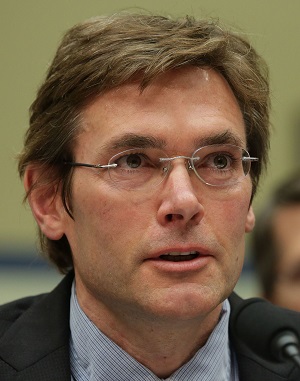
Source: Wikipedia
A keen studier of America’s aging infrastructure, Edwards pulled the veil back on ‘scientific misconduct’ of the Environmental Protection Agency and the Centers for Disease Control and Prevention dating as far back as 2001. He put together a report named: ‘A Public Health Tragedy: How Flawed C.D.C Data and Faulty Assumptions Endangered Children’s Health in the Nation’s Capital.”
In Flint, he found that the city had changed from a system where they initially got treated water from Detroit’s Water & Sewerage Department, to a system where they started consuming water from their own polluted river.
The situation was made more harmful due to the fact that the water was being distributed through old lead pipes. The water had purportedly transgressed the Safe Drinking Water Act four times. Flint’s treatment plant purportedly failed to use vital chemical treatments to prevent the corrosion of pipes - pipes that when corroded released lead into the water supply.
Edwards testified to the American Congress, accusing the Environmental Protection Agency of willful blindness to the pleas of inhabitants involved in the man made disaster. He accused them of being unrepentant, and unable to learn from their mistakes. Through his studies, he showed that the EPA’s malfeasance stemmed from 2001 all the way through to 2016.

“I guess being a government agency means you never have to say sorry,” Edwards said in his testimony. He believed that the Flint Water Crisis showed that there could be a dark side to science, engineering and academia.
Edwards explains that the installation of lead pipes into U.S. water infrastructure was a disaster and a tragedy. From 2000 to 2004 miscarriage and fetal death rates spiked due to mothers drinking water fed from lead pipes.
Even the Roman engineers as far back as the 1st Century BC knew not to use lead and water in the same system.
In February of 2016, in Flint, Michigan, it was revealed that the lead levels were 900 times higher than limits set by the Environmental Protection Agency.
Moral authority
Engineers should strive to operate in an ethical manner, thereby becoming the moral authority in their particular field of practice. Moral authority is defined as the quality or characteristic of a person, institution, or written work that is respected for having good character or knowledge, especially as a source of guidance or an exemplar of proper conduct.
In a bid to eliminate the chance of ethical or moral mistakes in the field of engineering societies were established in the 19th Century. The intention was to establish professional standards and ethical principles for engineers and their profession.
The American Society of Civil Engineers, for example, sets out the following ethical rule-of-thumb:
“Engineers shall hold paramount the safety, health and welfare of the public and shall strive to comply with the principles of sustainable development in the performance of their professional duties. “
The Institution of Civil Engineers’ creed reads:
“Members of the ICE should always be aware of their overriding responsibility to the public good. A member’s obligation to the client can never override this, and members of the ICE should not enter undertakings which compromise this responsibility. The ‘public good’ encompasses care and respect for the environment, and for humanity’s cultural, historical and archaeological heritage, as well as the primary responsibility members have to protect the health and wellbeing of present and future generations.”
Despite these strictures, around the world, from the governmental to the training levels of engineering, unethical practices persist and often snowball into tragic events.
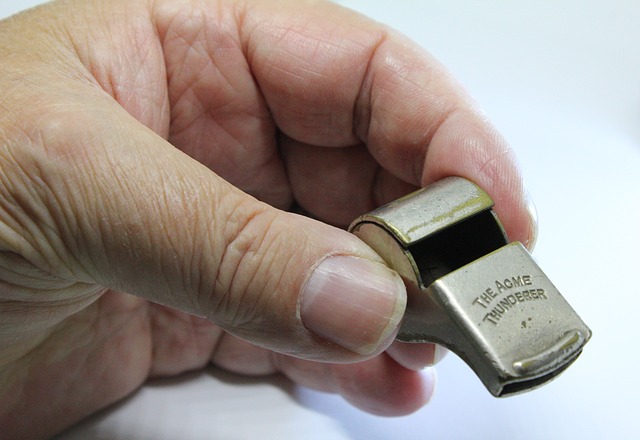
When an engineer notices abuses within the profession, those that transgress the ethical and moral principles that engineers should adhere to, blowing the whistle may be the answer. It does, however, take an enormous amount of courage and a considerable depth of knowledge. Marc Edwards had both and is to be commended.
Works Cited
“Marc Edwards | The Flint and Washington D.C. Drinking Water Lead Crises.” YouTube, Apr. 2016, youtu.be/dEgZpM6j6cc.
VirginiaTech. “Virginia Tech's Marc Edwards Testifies about the EPA's Role in Flint, Michigan.” YouTube, YouTube, 2016, www.youtube.com/watch?v=3VG57IWQfZ4&t=196s.
- Details
- Written by: Quintus Potgieter
Over the last five years renewable energy technologies have seen more investment than ever before. Many governments have made plans to phase out energy generating technologies that harm the planet, hoping to achieve a world powered by fully renewable energy generating technologies by 2030. Solar and wind are two industries that have particularly skyrocketed - in both research and implementation. An idea that hasn’t seen an equal amount of attention is the harnessing of one of Mother Nature’s most powerful forces; the ocean. Harvesting the energy of waves and ocean currents is, however, not a new concept; engineers have been hypothesizing its feasibility for quite some time.
 Research into the ocean’s energy is being conducted by Okinawa Institute of Science and Technology (OIST). Their graduate engineers and scientists have developed wave energy power turbines.
Research into the ocean’s energy is being conducted by Okinawa Institute of Science and Technology (OIST). Their graduate engineers and scientists have developed wave energy power turbines.
A project appropriately titled ‘Sea Horse’ is aiming to embed turbines in the seabed with mooring cables. The turbines will be aligned to capture wave energy and the ocean current that flows between Taiwan and southern Japan. The group’s first test of the turbines was purportedly successful - they are now seeking an industrial partner to turn the experiment into an electricity-generating commercial reality.
Professor Tsumoru Shintake at OIST and the Quantum Wave Microscopy Unit says that the turbines could even work alongside or in front of the current tetrapods on Japanese coastlines. Tetrapods are concrete structures engineered to weaken the strength of oncoming waves; common in coastal engineering. Shintake believes new ‘intelligent’ tetrapods fitted with wave energy turbines could generate renewable energy. He says:
“Particularly in Japan, if you go around the beach you’ll find many tetrapods. Surprisingly, 30% of the seashore in mainland Japan is covered with tetrapods and wave breakers.”
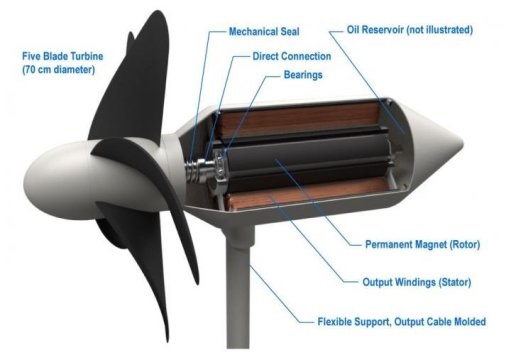
Shintake claims that the turbines, if installed in only 1% of seashores in mainland Japan would generate up to 10 gigawatts of energy. For context, the collective solar and wind power output in the United States at the end of 2015 was 100 gigawatts. A single nuclear power plant produces 1.21 gigawatts of power - meaning wave power could produce 10 times the amount of power a nuclear power plant could.
The turbines are designed with flexibility in mind. A turbine’s fins and its support stem are able to bend when a wave crashes into it and is able to handle tough conditions (rough seas, including extreme weather conditions).
According to the Bureau of Ocean Energy Management, the areas where ocean wave energy technology would be most effectively utilized include coasts of ‘Scotland, northern Canada, southern Africa, Australia, and the northwestern coast of the United States, particularly Alaska.’

Source: Professor Tsumoru Shintake
Works Cited
“Ocean Wave Energy.” Bureau of Ocean Energy Management, www.boem.gov/Ocean-Wave-Energy/.
“A Sustainable Future Powered by Sea.” Okinawa Institute of Science and Technology Graduate University OIST, 2017, www.oist.jp/news-center/news/2017/9/20/sustainable-future-powered-sea.
- Details
- Written by: Quintus Potgieter
360 to 500 buildings and homes are in danger of collapsing days after a magnitude 7.1 earthquake rocked Mexico City. The earthquake rattled the city on Tuesday, the 19th of September 2017. As many as 38 structures suffered catastrophic failure when the earthquake hit, but the concern for civil engineers is that other structures may yet suffer a delayed collapse. The earthquake has already caused up to 355 fatalities.
Engineers on popular social media site Reddit have been mulling over this shocking video of a building simply crumbling after the earthquake had hit the city. The overarching question was why there was “no resistance” to collapse.
The consensus among the engineers - the building appeared to have old masonry. Some pointed out that the sides of the building could have been brick; brick generally performs poorly (if not reinforced) during events such as earthquakes.
Engineering teams are now descending on Mexico City to generate data on the brittle buildings and to deliver reports to the Earthquake Engineering Research Institute (EERI).
A Matter of Geography and Geology
To make matters worse Mexico’s capital is built on an ancient lake and therefore on damp sand and clay. Its situation results in the prolonging of the earthquakes and increasing the damage to buildings, particularly to those which are five stories or more.

Virtual representation of the 19 September 2017 earthquake. Source: New York Times
When an earthquake strikes, the sediments the city is built upon slow the shock waves, leading to them strengthening and becoming more violent. To make matters worse the area is prone to earthquakes as it is near to the meeting of renowned tectonic plates.
This geological knowledge is not new so the question remains: why are Mexico’s buildings not better prepared for earthquakes?
According to the New York Times, building inspectors and private engineers have said that the strict building codes are not being enforced. A 2016 study revealed that many buildings failed to meet city standards - a staggering 71 percent of the 150 buildings studied, failed to meet standards.
A school that collapsed during the 19 September earthquake was marked safe by city inspectors after the earthquake 12 days earlier, on the 7th of September.
The Vice President of the Mexican Society of Civil Engineers, Sergio Alcocer said:
“We are concerned if we have a huge earthquake like the one in 1985 we may have problems in buildings. It’s a wake up call.”
Even the most recently constructed blocks of apartments in Mexico City tumbled down during the earthquake.
Buildings using concrete are said to be lacking vital reinforcing bars with concrete columns facing catastrophic failure during an earthquake if not properly reinforced. This apparently was the case in the collapsed Enrique Rebsamen school. 26 children lost their lives.
There is an urgent need for the review of civil engineering practices and standards in Mexico. More importantly, however, is the determination to enforce them.
Works Cited
White, Derek Watkins And Jeremy. “Mexico City Was Built on an Ancient Lake Bed. That Makes Earthquakes Much Worse.” The New York Times, The New York Times, 2017, www.nytimes.com/interactive/2017/09/22/world/americas/mexico-city-earthquake-lake-bed-geology.html?mcubz=1.
“A Building Suddenly Collapsing after a 7.1 Earthquake Strikes Mexico City. - Can Someone Explain Why There Is No Resistance as It Came down. • r/Engineering.” Reddit, www.reddit.com/r/engineering/comments/72armp/a_building_suddenly_collapsing_after_a_71/.
- Details
- Written by: Quintus Potgieter
War. What is it good for? Competition.
Smartphone companies have released their latest devices, all vying for a space in your pocket.
Smartphones bring together a plethora of engineering and design disciplines to create incredibly multifaceted devices that have no doubt changed the way humans interact with technology. And there seems to be no stopping the effect they have on consumers. We all want a new one, every year or two. And the competition usually sends engineers into all-out design frenzy to create new functionality they think will excite and buy-over the consumer.
Apple
 Apple has released the specs of their latest smartphone, introducing a host of new engineered additions to the flagship device, the iPhone X. The phone has been released to coincide with the release of the first iPhone, exactly 10 years ago. The company also released an iPhone 7 successor, the iPhone 8, which has impressive augmented reality features.
Apple has released the specs of their latest smartphone, introducing a host of new engineered additions to the flagship device, the iPhone X. The phone has been released to coincide with the release of the first iPhone, exactly 10 years ago. The company also released an iPhone 7 successor, the iPhone 8, which has impressive augmented reality features.
Head of Apple, Tim Cook, said that the release of the $999 iPhone X would ‘set the path for technology for the next decade’. The phone boasts an extended battery life when compared to the iPhone 7. More interestingly, the phone utilizes a new phone unlocking method called ‘FaceID’. Meaning, its users can gain access to their phone, and confirm purchases using the smartphone’s facial recognition capabilities.

The company does this through specialized hardware built for a set of machine learning algorithms - it also works with their Truedepth camera system that can even see a face in the dark thanks to an infrared camera and dot projection technologies.
The Apple engineering teams worked tirelessly to protect FaceID from imposters, utilizing mathematical models that map the face of the phone owner. The company says that the odds of another human being unlocking your phone are 1 to 1,000,000.
One ‘feature’ that Apple announced had already been a feature of Samsung devices, but they are carrying it further – the new iPhone X is basically ‘all-screen’ from edge to edge, and from top to bottom.
Samsung
Samsung, with their exploding Galaxy Note 7s in mind, came back swinging by bravely announcing a new line of Galaxy devices that were equipped with ‘Infinity Displays’. In retrospect, Samsung beat Apple to the punch with a larger screen surface.

The screens almost run the entire length of the phone, and they comb around the sides of the device - this was a main feature of their new Galaxy S8 and S8+ range.
But Samsung are venturing into even cooler territory. Reports suggest that, if all goes well, Samsung will launch a bendable smartphone in 2018. Bendable and wearable devices are the new in-thing for electronic and electrical engineering industries. Engineers have to adapt accordingly.
Samsung had already been alluding to eventual bendable devices in concept advertisements dating back to 2014. Other companies like Lenovo have also showed off concepts relating the future of the bendable device:
If the engineering limitations of bendable devices can be figured out in time they may be with us as soon as 2018, so says Koh Ding-jin, president of Samsung’s mobile business:
“As the head of the business, I can say our current goal is next year. When we can overcome some problems for sure, we will launch the product.”
The bendable smartphone may set an even greater precedent in the smartphone engineering industry and would be an even greater leap for technology than Apple’s iPhone X.
Further Chinese dominance and AI
 Don’t discount the other Chinese heavyweights that have entered and set precedents in the game. Huawei has slowly risen to the top to become countries like Africa’s first choice when it comes to purchasing smartphones. They are the second largest smartphone manufacturer in the world, as of September 2017.
Don’t discount the other Chinese heavyweights that have entered and set precedents in the game. Huawei has slowly risen to the top to become countries like Africa’s first choice when it comes to purchasing smartphones. They are the second largest smartphone manufacturer in the world, as of September 2017.
And they’re heavily investing into a Mobile AI that will allegedly dethrone Apple’s Siri. Apple’s machine-learning rhetoric with their iPhone X is paving the way for a much larger AI announcement, if recent reports are to be believed. Whoever engineers a functioning artificial intelligence, and port it into a smartphone, will win the smartphone game, predict analysts.
Google recently announced a partnership between them and Chinese company Xioami. They will enter 40 countries and then, along with Google, they will bring out an Android device that they hope will see consumer uptake.
The smartphone manufacturing game seems to bring together many engineering industries and pit them against each other to see who can design and develop the most desirable features for consumers. It is an exciting time for engineers with imagination and design capability.
Works Cited
“Design - 6.3’ Infinity Display | Samsung Galaxy Note8 – The Official Samsung Galaxy Site.” The Official Samsung Galaxy Site, www.samsung.com/global/galaxy/galaxy-note8/design/.
Lechman, Ashley. “Huawei Aiming for the Top Spot.” IOL Business Report, 2017, www.iol.co.za/business-report/huawei-aiming-for-the-top-spot-11017393.
McGoogan, Cara. “Apple Unveils IPhone 8 and £1,000 IPhone X with All-Screen Display and Wireless Charging .” The Telegraph, Telegraph Media Group, Dec. 2017, www.telegraph.co.uk/technology/2017/09/12/apple-iphone-8-iphone-x-launch-event-live-updates/.
- Details
- Written by: Quintus Potgieter
Cars are becoming more like smartphones every day. But is that necessarily a good thing? And what does it mean for the engineers who want to make a career out of automotive engineering? The days of the combustion engine seem to be coming to an end. The desire of tech companies and vehicle manufacturers is now to create fully autonomous, environment-friendly vehicles that takes individuals from point A to point B.
Elon Musk’s Tesla Motors is a good example of where the electric/smart vehicle market is going - customers seem to respond well to what is seemingly the future of mobility. However, it has been a rocky road for Tesla and its software-driven vehicles.
In 2016, a man lost his life in a Tesla car, after the Autopilot hardware and software inside the Tesla vehicle failed to recognize a trailer in the middle of the freeway.
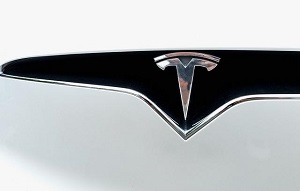
A year before that, Fiat Chrysler had to recall 7,810 Jeep Renegades with automated systems that could be exploited by hackers; a danger that they could be ‘remotely manipulated’. In response the company released USB sticks that would remedy the vulnerabilities and uploaded a safety update to the vehicles - it turned out that 1.4 million needed the update.
It follows then that as vehicles become more and more like computers they will need constant security upgrades.
Green-lighting OTA
On-the-fly software updates to the firmware inside vehicles are increasing rapidly. General Motors is the latest company to join the fray of vehicle manufacturers that are securing over-the-air (OTA) upgrades to their cars via a remote network. They can upgrade their network of vehicles with a click of a button, delivering specifically engineered code to their fleet of vehicles simultaneously
Software updates to a vehicle are becoming as easy as installing an app on a smartphone. According to ABI Research, 180 million new vehicles shipping between 2016 and 2022 will see the adoption of automotive over-the-air software updates.

“Three factors changed the course of the automotive industry and paved the way for the future of OTA: recall cost, Tesla’s success as the foundation of autonomous driving, and security risks based on software complexities,” said senior research analyst at ABI Research, Susan Beardslee. “It is a welcome transformation, as OTA is the only way to accomplish secure management of all connected car’s software in a seamless, comprehensive, and fully integrated manner.”
However, cybersecurity is a common concern among those critical of OTA updates. But with faster communication to the entire fleet of vehicles with OTA, the chances of blocking hackers’ attempts on vehicles could be more efficient than having to prevent hacking on individual vehicles as the need arises.
It is clear that the need for cybersecurity engineers in automotive engineering will grow and will need agile higher education institutions to step up.
Engineers interested in cars today can either work with the tech companies (like Apple, who are designing a fully autonomous car) or stick with the tried-and-tested vehicle manufacturers. The market is becoming more multi-faceted and interesting; a broader range of skills are required in the automotive engineering space than ever before.

Battery similarities
Automotive engineering companies are investing in the smartphone-vehicle-likeness by making vehicles battery powered. Lithium-ion batteries are found in our phones and will power your next car, but obviously on a grander scale.
After an emissions scandal, Volkswagen have pledged that they will invest up to $24 billion into zero-emissions vehicles by 2030 to try and challenge the already blossoming Tesla Motors. Volkswagen said that they will be manufacturing 80 new vehicles across its group by 2025. The company also wants to offer its other 300 group models in electric versions by 2030, Reuters confirms.
It seems there is no turning back for the unprecedented change the automotive engineering market is undergoing with the combustion engine heading into retirement? China has just announced that they will ban combustion engines within vehicles by 2040. Future engineers will become increasingly involved in e-mobility era in automotive engineering.
Works Cited
"ABI Research Anticipates Accelerated Adoption of Automotive Software Over-the-Air Updates with Nearly 180 Million New SOTA-Enabled Cars Shipping Between 2016 and 2022." ABI Research. Web. 11 Sept. 2017.
"As Your Car Becomes More like an IPhone, Get Ready to Update Its Software Regularly." Phys.org - News and Articles on Science and Technology. Web. 11 Sept. 2017.
Cremer, Andreas. "Volkswagen Spends Billions More on Electric Cars in Search for Mass Market." Reuters. Thomson Reuters, 11 Sept. 2017. Web. 11 Sept. 2017.
- Details
- Written by: Quintus Potgieter
Mazda has reinvented the wheel. Or rather, they claim they have reinvented the engine which drives that wheel.
They have engineered a ‘SkyActiv-X’ series of engines which purportedly use game-changing technologies which they believe will save the combustion engine from its seemingly inevitable demise.
The new engines use ‘Homogenous Charge Compression Ignition (HCCI)’. It is thought to be the ‘holy grail’ of combustible engines in a world which demands lower emissions.
SkyActiv-X shuffles between diesel engine compression and common spark ignition combustion engines in a best-of-both-worlds approach. They have assigned a name to this process; Spark Controlled Compression Ignition.
Mazda explains that this process of jumping between two kinds of compression can ensure that the engine works 20 to 30 percent more efficiently than its predecessors. HCCI engines are superior to that of standard gasoline and diesel engines because they remain cooler, resulting in a reduction of nitrogen oxide emissions.

The Mazda Motor Corporation has developed this next-generation engine to fit into their new long-term strategy aptly named ‘Sustainable Zoom Zoom 2030’. In terms of the details, however, Mazda is playing its cards close to its chest. As the cars near their release dates in late 2018, early 2019 more should emerge.
The question that persists with HCCI development is whether or not governments will trust further iterations of combustible engines as the world’s environmentalists call for the advancement of electrification.
Is it all for naught?
Britain has joined the list of countries determined to move to electric vehicles. They plan to ban the sales of petrol and diesel cars (and vans) from 2040 in an effort to curb nitrogen oxide levels in the country.
“Poor air quality is the biggest environmental risk to public health in the UK and this government is determined to take strong action in the shortest time possible. That is why we are providing councils with new funding to accelerate development of local plans, as part of an ambitious £3 billion program to clean up dirty air around our roads,” a government spokesperson said.
Governments have traditionally veered away from nuclear energy due to high profile incidents. Similarly, due to an increasing deluge of bad press, there is an increasing tendency to reject technologies that use ‘combustion’ and ‘engine’ in the same sentence. Furthermore, claiming to commit to a future of safer, electric-powered vehicles is a politically savvy decision at present.

The war against combustion engines could make Mazda’s last ditch effort for the ideal internal combustion engine an engineering non-starter. Mazda’s Research and Development head Kiyoshi Fujiwara says: “Electrification is necessary but...the internal combustion engine should come first.”
Germany’s Angela Merkel, despite the pressure of world-renowned German automotive engineering companies, has also issued statements pointing to the retiring of internal combustion engine technologies. In a recent speech she said:
“Large sections of the auto industry have gambled away unbelievable amounts of trust. This is trust that only the auto industry can restore. And when I say ‘the industry’ that is the company leaders.”
Critics, however, say that the move to electrification in Germany may cause 900,000 job losses in the country. What remains clear is that the pressure on phasing out the internal combustion engine vehicle for the next big thing in vehicle engineering technology is going to be a bumpy road.
Works Cited
Asthana, Anushka, and Matthew Taylor. "Britain to Ban Sale of All Diesel and Petrol Cars and Vans from 2040." The Guardian. Guardian News and Media, 25 July 2017. Web. 16 Aug. 2017.
Jamieson, Craig. "Here's How Mazda Plans to save the Internal Combustion Engine." Top Gear. Top Gear, 08 Aug. 2017. Web. 16 Aug. 2017.
- Details
- Written by: Quintus Potgieter
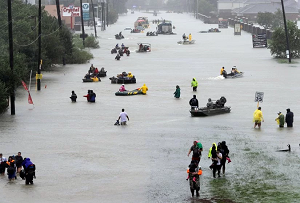 Friday night (the 25th of August) a tropical storm hit Texas in the United States of America. 60cm of rain fell overnight (23 inches) with a total of 50 inches expected before the week was out. Whether or not Texas’ drainage system is able to deal with the volume of water that climate change is bringing will be a pertinent question once relief efforts have been fulfilled. Questions surrounding Houston’s water infrastructure are already being asked.
Friday night (the 25th of August) a tropical storm hit Texas in the United States of America. 60cm of rain fell overnight (23 inches) with a total of 50 inches expected before the week was out. Whether or not Texas’ drainage system is able to deal with the volume of water that climate change is bringing will be a pertinent question once relief efforts have been fulfilled. Questions surrounding Houston’s water infrastructure are already being asked.
A New York Times opinionista has pointed to climate change as the leading cause for Hurricane Harvey’s wrath whilst accusations of America’s hand in contributing to global warming persist. Simultaneously many face practical considerations - what to do in the aftermath of an infrastructure-crippling hurricane.
The devastation caused by Hurricane Harvey will encourage engineers to lend their minds to climate science studies and funnel this knowledge into solutions for a world facing an increase in natural disasters, many of which involve flooding. The lack of engineering foresight, thus far, has been highlighted in neighboring state Louisiana.
No lessons learned
In New Orleans, Lousiana, critical water infrastructure (pumps and canals) were not prepared for heavy rainfall this hurricane season. This is despite the New Orleans’ levee failures in 2005, during Hurricane Katrina. Those levee shortfalls can be found in case studies comparing them to some of the largest engineering failures of all time - including Chernobyl. Furthermore, the studies pertaining to Katrina clearly highlighted the inadequacies of the civil engineering practices within the United States Army Corps of Engineers.
New Orleans experienced a spate of floods on August 5th of this year, with Louisiana’s governor declaring a state of emergency as a result of the flooding. According to the New Orleans Advocate, repairs and maintenance on pumping stations reduced their efficiency by a third!
To give a little clarity to the problem: the drainage system in New Orleans is designed to deal with one inch of rain in an hour, and a half an inch each hour after the first. With this in mind, and according to the Economist, four out of five turbines were not working at one of the state’s pump stations during the floods, and other pumps, in harder hit areas, were down for maintenance. Elsewhere, staff shortages led to inefficiencies so pumps were not switched on in a timely manner.
The citizens in flood-hit areas of New Orleans have accused the sewerage and water board, (amidst other allegations of incompetence) of uncleaned/cleared catch basins which prevented water from moving to the drainage systems. This latest event has led to a political crisis in New Orleans. Officials, however, have said that old and poorly maintained infrastructure is an America-wide problem.
Thankfully New Orleans seems to have escaped the worst of Hurricane Harvey, avoiding the full brunt of the catastrophe 12 years after Hurricane Katrina.
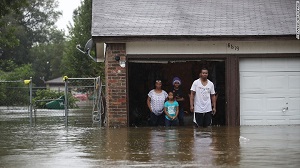
Texas
The rising waters in Houston have resulted in a double-explosion at a chemical plant and, at the time of publishing, the hurricane has led to the deaths of 50 people.
The chemical plant belonged to Arkema Group, one of the world’s largest chemical companies. The coolant systems and power generators were rendered useless due to the floodwaters, and as a result the Arkema Group warned that an explosion was soon to follow. The plant exploded sending a large black plume of smoke into the air and forced police to evacuate an area of up to 1.5 miles. The Environmental Protection Agency (EPA) said that no toxic materials were reported to have been released but will continue to monitor the situation as more explosions are possible.
In Beaumont, Texas, flooding has caused the city’s water pumps to fail, causing 118,000 people to be without any running water. Hospitals have had to evacuate their patients and transfer them elsewhere due to the lack of water.
The Atlantic reports that the Association of State Floodplain Managers in Houston has tried to get funding for flood control, but in vain. Without engineering expertise in storm water management technologies it is unsurprising that an event such as Hurricane Harvey has wreaked such havoc.
City planning has also copped some criticism. An excerpt from the Atlantic’s article points to the fact that Houston and New Orleans’ cities are in flood-prone areas:
“The hardest part of managing urban flooding is reconciling it with Americans’ insistence that they can and should be able to live, work, and play anywhere. Waterborne transit was a key driver of urban development, and it’s inevitable that cities have grown where flooding is prevalent.”
And it seems that Houston’s everyday citizens knew that a hurricane would inevitably cause a flood.
People outside of HOUSTON believe this is a ONETIME thing but this HAPPENS every 2 MONTHS or SO .. BAD ENGINEERING & FLOOD CONTROL pic.twitter.com/oRaX8x7IWg
— Aristotle Onassis (@OnassisHa36) August 28, 2017
This is gonna be fun... But we have to appreciate the City of #Houston Public Works and Engineering team. Or else this would be much worse. pic.twitter.com/YKow0yrKxy
— TheGreatNike (@XboxNike) August 27, 2017
Works Cited
Bogost, Ian. "Houston's Flood Is a Design Problem." The Atlantic. Atlantic Media Company, 28 Aug. 2017. Web. 31 Aug. 2017.
Leonhardt, David. "Harvey, the Storm That Humans Helped Cause." The New York Times. The New York Times, 29 Aug. 2017. Web. 31 Aug. 2017.
- Details
- Written by: Quintus Potgieter

The United States has just witnessed the first total solar eclipse in 38 years. For some US states people would have observed a partial eclipse, but for 14 other states, the moon would have blotted out the sun completely. 2 minutes and 38 seconds of darkness was experienced in Madras, Oregon.
The next total eclipse will appear in American skies on April 8, 2024.
The power grid effect
An obvious impact of a solar eclipse is on photovoltaic cells that rely on the sun’s rays to generate power.
Steven Greenlee from CAISO - one of the largest independent grid operators in the world –commented, “Our solar plants are going to lose over half of their ability to generate electricity during the two to two and a half hours that the eclipse will be impacting our area,”
It is unlike a cloudy day because with an eclipse the loss causes a rapid decline and rebound of solar power that grid operators have to carefully manage.

The U.S. Energy Information Administration (EIA) explained that 70 percent or more of the sunlight for utility-scale solar power plants would be obscured during the solar eclipse.
Source: EIA
It has taken grid managers a year to prepare for the three hours of obscured sunlight. A startling fact when one considers that solar power only makes up 1 percent of the overall US power supply.
Another interesting fact: wind power cannot take up the slack during an eclipse and the drop in solar power because wind drops off too wind slackens during a solar eclipse as well.
Scientists and engineers have used the solar eclipse as a tool for research - keeping an eye on how technology reacts to an event that disrupts both space weather and weather itself.
Chasing an eclipse with engineering
Teachers and students in STEM-related classrooms in schools and universities across the United States ensured that they were ready for the solar eclipse; for example pinhole projectors were built to allow for the safe viewing of the event.
NASA took the eclipse very seriously, ensuring it was scrupulously tracked.
Utilizing specially engineered telescopes mounted to the front of two retrofitted WB-57F aircraft, NASA tracked the shadow of the moon as it shifted across the United States. The aircraft’s telescopes would also capture the Sun’s outer atmosphere (the Corona) during the solar eclipse and also took thermal images of Mercury. The sun’s atmosphere is usually harder to study without a solar eclipse, so it was a valuable moment in time.
The planes climbed to 50,000 feet, progressing through most of the Earth’s atmosphere to obtain the best images possible. Eleven other land-based investigations of the Sun’s atmosphere took place during the solar eclipse too.
Dan Seaton, a co-investigator of the project and researcher at the University of Colorado in Boulder, Colorado, believes the high altitude observations will be more advantageous than those from the ground. He spoke to NASA saying:
“These could well turn out to be the best ever observations of high frequency in the corona. Extending the observing time and going to very high altitude might allow us to see a few events or track waves that would be essentially invisible in just two minutes of observation from the ground.”
This quote that follows is anonymous, but reflects on most all of us during the light of day. Throughout the eclipse, however - just as with the night – most were perfectly still:
“Every morning in Africa, a Gazelle wakes up. It knows it must run faster than the fastest lion or it will be killed. Every morning a Lion wakes up. It knows it must outrun the slowest Gazelle or it will starve to death. It doesn't matter whether you are a Lion or a Gazelle; when the sun comes up, you'd better be running.”
Works Cited
DiChristopher, Tom. "The Total Solar Eclipse Is Going to Knock out a Lot of Solar Power." CNBC. CNBC, 21 Aug. 2017. Web. 21 Aug. 2017.
Garner, Rob. "Chasing the Total Solar Eclipse from NASA's WB-57F Jets." NASA. NASA, 25 July 2017. Web. 21 Aug. 2017.
Choi, Annette. “Solar eclipse 2017: how the solar power industry is prepping for a huge blip” VOX, 20 Aug 2017.Web 24 Aug 2017.
- Details
- Written by: Quintus Potgieter
A pedestrian bridge on the N3 road in Bedfordview, in Johannesburg collapsed in the early hours of the morning on Tuesday the 8th of August 2017. The bridge collapsed onto four vehicles, resulting in five injuries with zero fatalities.
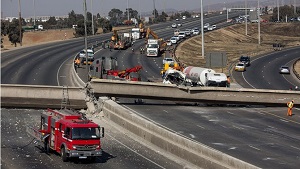
The highway has been re-opened since the collapse. Transport Minister Joe Maswanganyi finds the collapse odd, saying the bridge was deemed safe in 2016. He said: “Sanral did an inspection of the bridge and we were told that the bridge was in a good condition and we have a certificate in that regard. What happened on Wednesday was shocking.”
The bridge was built in 1978. It was recently decommissioned and thus regarded as an abandoned bridge but still thought to be rigid enough to stay standing.
The transport minister has tasked forensic experts and officials from the Council for Geoscience and Sanral (South African National Roads Agency) with investigating what caused the bridge’s collapse.
Rubble removal teams spent the public holiday on Wednesday removing the collapsed bridge to allow traffic to flow.
Speculation
Whilst the investigation progresses armchair critics are offering possible causes for the bridge’s demise. Some of these assessments point to another disaster which occurred at a similar time: an earth tremor apparently triggered by the collapse of an illegal mine. The reports of this illegal mine caving in are unverified, but could certainly account for the accident if proved true.
Dr Eldridge Kgaswane, scientist for the Council for Geoscience was, however, skeptical. He pointed out that there had indeed been a tremor, but because it only measured 2.0 on the Richter scale was an unlikely cause. He suggested that a tremor measuring around 6.0 would have been a more likely catalyst for the bridge’s collapse.
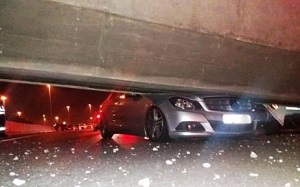
Talking to IOL (a South African news website), a ward councilor Gill Humphreys says that vandalism could have been the cause. She pointed out the bridge had been tampered with for years, “Over this time, it has been stripped of nuts and bolts and all steel reinforcing. We are questioning why Sanral did nothing to ensure the safety of the bridge, as this almost certainly caused the collapse.”
Questions have also been asked about a truck bumping into it at some point and whether this had compromised the structural quality of the bridge.
Another more outlandish online allegation is that a bomb caused the pedestrian bridge to fall. At the time of publishing, however, none of these rumors have been confirmed.
The validity of infrastructure inspections has been questioned following the collapse. Engineers now tirelessly work to end the speculation. SANRAL delivered a statement reading:
“We are relieved that we managed to clear the debris and open the road in less than 48 hours. We wish to thank the teams involved in the collaborative effort to clear the site. At the same time, we have not forgotten those who were injured during the bridge collapse. We wish them a speedy recovery and are keeping them in our prayers.”
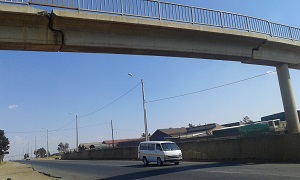
Avoiding future collapses
Twitter users are warning that more bridge collapses could occur in South Africa. They believe their age is one of the factors compromising their structural integrity. This photograph of a pedestrian bridge at the R61 next to Angus Station in Ekurhuleni clearly shows signs of structural disintegration.
They are asking for their photos to be retweeted in an effort to motivate their municipal governments to do something about these aging bridges.
A probe into what caused a bridge scaffolding collapse back in 2015 on Grayston Drive in Johannesburg is still ongoing. The bridge collapse caused the death of two and injured 19. What remains apparent is that South African civil and structural engineering entities need to take bridge construction, assessment and maintenance more seriously in years to come to avoid potential catastrophic failures.
Works Cited
Cox, Anna. "Industry News." Vandalism May Have Led to Bridge Fail | IOL Motoring. 10 Aug. 2017. Web. 10 Aug. 2017.
"Johannesburg N3 Bridge Collapse: Traffic Flow Restored, but Questions Remain over Inspections." Daily Maverick. Web. 11 Aug. 2017.
- Details
- Written by: Quintus Potgieter
What can house 1,000 passengers, a boatload of cargo, and 850 vehicles? You guessed it. A ferry.
The UK Government’s Department of Transport in their 2016 Provisional Sea Transport Report stated that the number of international short sea passengers was estimated at 20.0 million people in that year. Norway also utilizes ferries in a big way. Until the completion of the first underwater tube-shaped floating tunnel, the only way to navigate Norway’s fjords is via ferries.
With that many people utilizing the form of transport, it is in the best interest of the engineering companies that run them to regularly perform maintenance on the ships. Extending the lifetime of a ferry is a three week slog, that guarantees the ferry another ten years of operation.
A little South of Norway, a battalion of ferries operate in the North Sea, enabling transport between a number of countries including the United Kingdom, France, Germany and Belgium. One of the ferries that should be up for its next maintenance operation in 2022 is the Pride of Bruges. The ferry consists of 32,000 tonnes of steel, 7 football field sized decks, with 4 engines which burn two and a half thousand litres of fuel an hour. It was renovated in 2012.
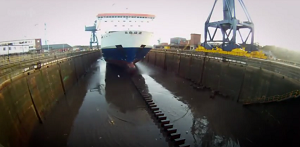
Exterior
The operation involving exterior and interior maintenance takes an army to complete. The Newcastle engineering team consists of 120 engineers who work on the boat, examining over 1,000 separate parts.
The most critical parts of the ferries which require attention are underwater; if it is not docked, the boat cannot be repaired, maintained or renovated.
Thus, the first challenge is getting a mammoth ferry into the ferry lock. The lock is flooded with 133 million litres of water that allows the ferry to be pushed into the lock. After that, the water is emptied out so that the ferry can be accessed and assessed on dry land. Most of the engineering works are below the water line.
Once the hull of the ferry is accessible to the engineers, one of the first things investigated are the ballast tanks. Ballast tanks are compartments within a floating structure which take water in, in order to ensure stable buoyancy. The tanks are emptied and cleaned so that the overhauling of them can begin. Corrosion proofing ensues within the inner steelworks.
When the ferry is functional, water is pumped in and out of the ballast tanks, based on the buoyancy required. Engineers explain that saltwater and freshwater have different buoyancies. There is a measurement ruler on the side of the boat that suggests water levels for the different buoyancies.

Another crucial element of the ferry that must be checked, over and above everything else, are the retractable fins, known as stabilizers. They keep the boat from rocking back and forth and giving the crew sea sickness. Actuators ensure that they are perfectly synchronized on either side of the ship.
The most common of all ferry maintenance is performed on the steel boat itself. Seawater corrodes the steel, thus it needs to be constantly weather proofed to avoid rust and wear. To avoid seawater from eroding to the point of catastrophic failure sacrificial anodes are fitted to the hull - they take the brunt of the seawater damage so that the steel beneath it doesn’t corrode as quickly.
The ship’s two propellers are also polished. They are closely studied to detect cracks and other surface imperfections; fractures must be fixed. Propellers suffer from what is known as cavitation erosion. This occurs because of the implosion of water bubbles around the propellers during the ship’s operation. It has the ability to render propellers useless. Thus, polishing them ensures a longer lifetime.
Finally, rudders are checked to ensure that the boat can be maneuverered back into the sea. Controlled by hydraulic actuators, the rudders are controlled by the captain housed inside the bridge.
Interior
Aside from maintenance to the exterior, the complex technological systems responsible for, among other critical jobs, steering the ship, require trouble shooting and checking. These computers are vital to the smooth running of a ferry.
Global positioning systems are also being installed in ferries to make sure that captains are aware of exactly where they are going and to monitor other boats that are filling up shipping lanes.
Further inside the ship, the replacing of steel floors occur where the car deck is positioned. Wear and tear of the steel flooring occurs due to the tonnes of cars that weigh the steel down during its lifetime. A new layer of steel is placed atop the old one.

Image of the boat traffic between the English Channel.
In the engine room, refurbished barrel-sized pistons are positioned to fire away once the ferry is ready for action again. The pistons cost £15,000 per piston. 30 pistons are required for a ferry the size of the Pride of Bruges.
These are just some of the engineering challenges involved when maintaining ferries. On completion they are carefully moved from their locks back into the ocean. After their three weeks in dry dock they should remain in good shape for another decade. These maintenance visits keeps the teams of repairers on their toes; delays are extraordinarily costly.
Works Cited
"Engineering Giants - 3. Ferry Strip-Down." BBC IPlayer. BBC. Web. 10 July 2017
- Details
- Written by: Brad Lohoar
 It is often difficult for engineers to position themselves into the search engines result pages (SERP's) because of the very competitive nature of the industry. It is dominated by the worlds major companies and the smaller more regional firms often find themselves on the back pages.
It is often difficult for engineers to position themselves into the search engines result pages (SERP's) because of the very competitive nature of the industry. It is dominated by the worlds major companies and the smaller more regional firms often find themselves on the back pages.
It is therefore vitally important that you do a SWOT analysis, that is, an internal study of your strengths and weaknesses as well as your opportunities and threats.
Once you understand yourself, have a look at your direct competitors, not just in your area of expertise but also similar firms in different regions. Look for where they rank, how the pages are laid out and what type of content they use.
Content is critical.
Do not try to impress with language that only a 10 year industry expert can understand. Remember, those looking to engage you are not necessarily the decision makers, it may be an executive assistant, secretary or office junior.
Have photos and a brief profile description of the owners and principles of your company, I would not put up all your employees as your competitors will probably try to poach them (you may have a couple of under-performers, so it may be a good thing).
The same goes for successful projects that you have completed, a few photos and a brief description of what you have done, once again, keep the language simple, and don't give away your key contacts/clients, your competitors are always looking for work.
Don’t be afraid to place your “job opportunities” on your website with an application lodgement form. If you don’t currently have any open positions, you will be amazed at who "appears" in your inbox. Economically it makes sense, I know of one firm who saved over $200K in recruitment fees in 6 months.
Make sure that you are not "too" broad in your descriptions of what you do, try to create a "point of difference". Have you ever noticed how well a "spelling mistake" ranks?
- Use bullet points - Bullet points help with the readability of your content and allow for a fast intake of content.
- Use relevant headings - This helps with the readability and allows readers to skim to the specific areas that interest them.
- Use relevant images - Stay away from stock images, some projects will not allow photos without permission.
Once you have got your content sorted, the rest is relatively simple.
- Page load speed - Ensure your site loads quickly on all devises and in all regions.
- Mobile friendly - The uptake of mobile visitors is well over 60% of web traffic, have a look at your site on your phone.
- Phone number - Top right hand corner of the page with a hyperlink to phone.
- Contact form - Name, Phone, Email, you do not need to know what they had for breakfast.
On completion of the above, the readability and usability of your site will be far better than average.
Having original relevant articles, written consistently, and posted on your site, maintains a freshness that the search engines want to see. (These articles can be used in your newsletters.)
Good, honest, fresh, relevant content with a site that loads quickly on multiple devices in multiple regions will ensure that you will improve your rankings. Why? because your competitors don't do it.
More in a couple of weeks
- Details
- Written by: Edwina Ross
The Rio-Antirrio Bridge is a modern engineering marvel that, at its heart, relies on engineering expertise and lessons from the past. Opened in August 2004, the bridge wowed engineers because it reflects and marks the progress of bridge building through history. The bridge is one of the longest multi-span, cable-stayed, suspension bridges in the world.

Credit: By Eusebius, CC BY-SA 3.0, https://en.wikipedia.org/w/index.php?curid=39009078
The bridge links the Peloponnese peninsula to mainland Greece. These landmasses have moved further and further away from each other over hundreds of years, subsequently creating what is known as the Gulf of Corinth. The 2 mile gap was not the only unique challenge the Gulf of Corinth presented to engineers. The other challenges were the strong winds in the middle of the channel, and the fact that the bridge was going to cross one of the largest seismic zones in Europe.
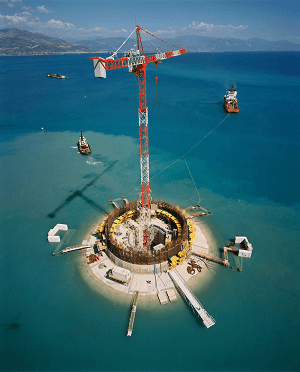
Too much ground to cover
A 2 mile stretch is too wide for a single span bridge; engineers realised they had to develop a multi-span bridge. In the planning stages the depth of the water posed the initial setbacks; the Gulf of Corinth is sixty meters deep.
The answer was to use hollow, concrete, floating barges. This engineering concept was the brainchild of engineer Guy Maunsell, who invented floating forts for the purposes of battle during World War 2. Offshore wind turbine operations use these floating barges and they are commonly employed in modern day bridge building. Between 1998 and 2001, the four hollow pier foundations, needed to construct the Rio-Antirion Bridge, were floated into place.
Avoiding Natural disasters
Instead of burying the foundations in the ground, they were set atop the seabed, which had been reinforced by steel bars and ten feet of gravel. This was to ensure that the bridge could move with the ground during earthquake activity, to reduce the risk of the bridge being damaged by an earthquake. This is now known as seafloor stabilization, but it was a first in engineering bridge building history.
To further avoid the seismic activity’s effect on the bridge’s structure, the engineers implemented jacks and dampers that absorb any earthquake activity. Basically, the bridge has enormous shock absorbers.
Credit: "GEFYRA - Nikos Daniilidis"
Furthermore, the bridge is completely suspended to ensure that earthquakes do not make the bridge sway. It is held in place by 348 cables. The cables are made of single strands of steel grouped together to form one large cable. The steel strands are more flexible and collectively stronger than iron. Previously iron had been used on bridges that had experienced catastrophic failure.
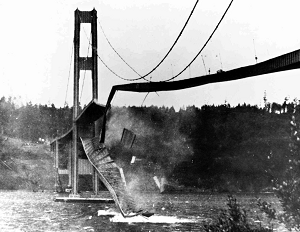
The Tacoma Narrows Bridge. Credit: Seattle Times
To guard against damage from the wind the bridge uses the same aerodynamic wind diffusing fairings and spoilers that you would expect to see on a car, but on a grander scale. The cables are also wrapped with spiral Scruton strakes that allow wind to flow around the cables instead of straight into them.
These civil engineering nuances of bridge building may have saved the Tacoma Narrows Bridge in 1940. It was given the nickname ‘Galloping Gertie’ due to the effects of the winds; its vertical sway caused catastrophic failure. The Tacoma Narrows Bridge disaster serves as a case study and explains why the Rio-Antirrio Bridge used a system of cable-stays and suspension bridge construction technologies instead.
The Rio-Antirrio Bridge is considered a modern masterpiece. The engineers are applauded for their considerations of past bridge failures, and for their ability to come up with solutions to problems that had never before been addressed in the industry. And that is why this bridge is considered a modern engineering marvel.
Works Cited
RION-ANTIRION BRIDGE - An Engineering Marvel - Dr. Carolyn Pararas-Carayannis. Web. 20 June 2017.
Panajotisx. "Rio Antirrio Bridge - Challenging Earthquakes." YouTube. YouTube, 19 Jan. 2014. Web. 20 June 2017.
- Details
- Written by: Quintus Potgieter
IBM has come a long way since they introduced their first personal computer in 1981. The advent of the device transformed the world. In the 36 years since then engineers have continued to innovate with computer technology, some might say that the effect computers have had on society is beyond measure.
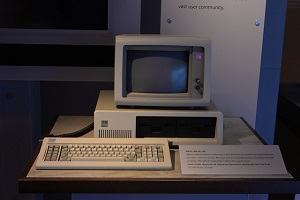
Photo credit: THE Holy Hand Grenade! via Foter.com / CC BY-ND
The history of computers reaches to a period long before 1981, but IBM’s maiden voyage into unfamiliar territory undoubtedly changed the game, and influenced countless numbers of engineers. It was, after all, the International Business Machine.
Now personal computers are everywhere; in our pockets, in our televisions, and even in our watches. And, unfortunately for the technophobic, almost everything in our world is becoming a computer, thanks to the Internet of Things.
The World Economic Forum is closely monitoring the development of computers, tracking their role in creating a better world. As we know computers have had an immense impact on the industrial, commercial and domestic environments in the 21st century; this has encouraged the World Economic Forum to put them on their agenda. They plan to influence the changes that revolutionize the technologies involved and to measure the effect of the internet. Justine Cassell, the Associate Vice-Provost for Technology Strategy and Impact at Carnegie Mellon University, wrote a report for the WEF,
“In the same way we have a tendency to think of computers as rectangular boxes, we have a tendency to think of the internet as being some kind of ether that floats around us. But quite recently researchers have made enormous breakthroughs in creating a way for all objects to communicate; so your phone might communicate to your refrigerator, which might communicate to the light bulb. In fact, in a near future, the light bulb will itself become a computer, projecting information instead of light.”
Designing the future
IBM is continuing the trend of engineering the future with computational technologies (software and hardware), enabling engineers to work more efficiently and build a more interconnected, smarter future. They do this with what they call ‘Continuous Engineering’. They write:
“IBM IoT Continuous Engineering helps teams keep on top of the complexity of developing smart, connected products. Running in the cloud, it helps systems engineers and software developers to deliver against requirements, respond efficiently to change and create high-quality designs faster-- while controlling development costs and meeting compliance needs.”

In truth, many tech companies are tirelessly working at equipping computers with the ability to interconnect almost everything; from our clothes, to our cars, to our houses. They’re trying to make machines more intelligent, so they can do the repetitive tasks that humans find frivolous. In essence they want computers to think for us.
The first evidence of this is perhaps no better exemplified than in the recent boom of in-home artificial intelligence assistants. These devices use hardware and software and an internet connection which is connected to an artificial intelligence. This intelligence learns your preferences, understands what you need when you need it, and can talk to you as well.
Artificial intelligence
IBM has their very own ‘Watson’, Amazon has ‘Alexa’ and Google has their ‘Home’ device. The future of computers seems to involve engineers attempting to build seemingly omniscient machines. But are they getting it right?
Jeff Hawkins, founder of Palm Computing Inc, the company behind the Palm Pilot, has moved on to neuroscience technology. His new company, Numenta, utilizes the current technology within the neuroscience and engineering industry, in the hopes that it will enable computers to mimic the human mind. He writes:
“The solution is finally coming within reach. It will emerge from the intersection of two major pursuits: the reverse engineering of the brain and the burgeoning field of artificial intelligence. Over the next 20 years, these two pursuits will combine to usher in a new epoch of intelligent machines.”
Numenta discovered that for machines to think like humans, they need what is called sensorimotor integration. To see and ‘feel’ the world in the same way humans do. Hawkins calls it the “principle of combining movement with changing sensations”. Hawkins believes computers need to mimic the absorption of information which is traditionally the responsibility of a human neocortex. Unless they are programmed with this capability the ‘intelligent machine’ will remain elusive,
“Intelligent systems need to learn multidimensional models of the world. Sensorimotor integration doesn’t occur in a few places in the brain; it is a core principle of brain function, part of the intelligence algorithm. Intelligent machines also must work this way.”
The video below from IEEE sums it up:
Hawkins’ aim is to reverse engineer the neocortex and understand it from back to front so that he can somehow transfer that understanding into a computer. He says he does not think that those working in machine learning and artificial intelligence are aiming high enough. He concludes:
“While it is exciting for today’s computers to classify images and recognize spoken queries, we are not close to building truly intelligent machines. I believe it is vitally important that we do so.”
Works Cited
IBM IoT Continuous Engineering. 27 June 2017. Web. 27 June 2017.
Hawkins, Jeff. "What Intelligent Machines Need to Learn From the Neocortex." IEEE Spectrum: Technology, Engineering, and Science News. IEEE Spectrum, 02 June 2017. Web. 28 June 2017.
Written by Justine Cassell, Associate Vice-Provost for Technology Strategy and Impact, Carnegie Mellon University. "By 2030, This Is What Computers Will Be Able to Do." World Economic Forum. Web. 27 June 2017.
- Details
- Written by: Quintus Potgieter
Is it okay to fail? Engineering failure can be and has been a good thing; it is after all how we learn and how engineering designs improve. But it can be catastrophic; the tragic failure of a bridge, for example. There is another sort of failure in engineering: companies which have released products to the masses without adequate take-up have experienced market failure.
 Failure for these companies usually means sending product engineers back to the drawing board; it is often very difficult to gauge whether or not there is a demand for a product. Nurturing skills in business and entrepreneurship, however, will hold engineers in good stead by giving them the edge when it comes to assessing the market and its demand for engineering merchandise.
Failure for these companies usually means sending product engineers back to the drawing board; it is often very difficult to gauge whether or not there is a demand for a product. Nurturing skills in business and entrepreneurship, however, will hold engineers in good stead by giving them the edge when it comes to assessing the market and its demand for engineering merchandise.
To show that companies are prone to designing, engineering, and manufacturing products that fail a Swedish town has opened a new museum. It is completely devoted to displaying the failed products that the world has seen throughout the ages. A clinical psychologist named Samuel West was behind the idea and his motivation for opening the Museum of Failure Innovation? He reckons that failure is a good thing.
“Even the biggest, most competent companies fail. The trick is to create an organizational culture that accepts failure so that you can fail small...rather than fail big,” West says. West displays some of the most recognizable failures that were seen on a global scale.
 The Nokia N-Gage was poised to be the mobile phone of the future. Half-phone, half-handheld-gaming system, this was the must-have device of the naughties.
The Nokia N-Gage was poised to be the mobile phone of the future. Half-phone, half-handheld-gaming system, this was the must-have device of the naughties.
Initially the demand for it was quite high, but it had some design quirks: one of these entailed holding the phone vertically on its thick edge, whilst putting the thinnest edge to your ear to hear your caller. The buttons were also oddly laid out. It just wasn’t practical.
On top of this the device lacked good gaming titles. Ultimately the phone lost its value to customers.
 Long before the iPod, iPad, and Siri, was Apple’s failed digital assistant Newton. It was a very basic Palm Pilot, built three years before the Personal Digital Assistant was a thing.
Long before the iPod, iPad, and Siri, was Apple’s failed digital assistant Newton. It was a very basic Palm Pilot, built three years before the Personal Digital Assistant was a thing.
Steve Jobs, upon his return to Apple in 1997, allocated engineers positions in the designing and manufacturing of what would go on to be the iPod. Jobs, in Walter Isaacson's official biography, lamented:
“My gut was that there was some really good technology but it was [screwed up] by mismanagement. By shutting it down, I freed up some good engineers who could work on new mobile devices. And eventually we got it right when we moved on to iPhones and the iPad.”
But it’s not all doom and gloom with Apple’s Newton. It is a perfect example of how a device, with no real customer interest, set the stage for the rise of an engineering design that changed the world. That design being the eventual iPhone.
 West has even put the two-wheeled engineering marvel, the Segway, into his museum of failure. Segway Inc spent $100 million developing their product. They went on to sell each one at an unrealistically high price of $3,000 for the entry-level version and $7,000 for the premium vehicle.
West has even put the two-wheeled engineering marvel, the Segway, into his museum of failure. Segway Inc spent $100 million developing their product. They went on to sell each one at an unrealistically high price of $3,000 for the entry-level version and $7,000 for the premium vehicle.
According to TIME, the company only sold 30,000 units between 2001 and 2007. The world wasn’t convinced that it was the ‘next big thing’ for getting from A to B.
“The Segway was supposed to revolutionize the way we transport people. And we all know that Segway today is used by tourists before they go get drunk,” West said sardonically.
Google also thought it could revolutionize our worlds and put our smartphone and smartwatches directly on our faces. They released a product named Google Glass - a head-mounted augmented reality wearable computer. The engineering of wearables is now commonplace within engineering disciplines and this will inevitably drive the cost down. But Google, in 2013, seemed to have put the cart before the horse.
 Google Glass was released at an expensive price point of $1,500. The market felt it wasn’t adequately function-filled to justify that, in other words, $1,500 seemed a bit steep for a pair of cool shades. The product never really left beta testing;
Google Glass was released at an expensive price point of $1,500. The market felt it wasn’t adequately function-filled to justify that, in other words, $1,500 seemed a bit steep for a pair of cool shades. The product never really left beta testing;
Nonetheless, the future of head-mounted augmented reality wearables is bright, as shown with the Microsoft Hololens. It is clear therefore, that engineering failures bring about more innovation in the long run. However, for those products that miscarried, they now have a new home, in the Museum of Failures.
The world is now left wondering what fascinating engineering design will rise and fall next. Perhaps the latest craze, the fidget spinner will suffer the same fate, and find itself in West’s historical failures museum?
Works Cited
St., 24/7 Wall. "The 10 Biggest Tech Failures of the Last Decade." Time. Time Inc., 14 May 2009. Web. 26 June 2017.
Weller, Chris. "13 of the Biggest Product Flops Featured in Sweden's New 'Museum of Failure'" Business Insider. Business Insider, 14 June 2017. Web. 26 June 2017.
- Details
- Written by: Quintus Potgieter
 To be cyber secure is becoming increasingly difficult because our interconnected world poses greater risks. The battle continues nonetheless; cybersecurity professionals are emerging in larger numbers and installed cybersecurity software and hardware is now essential across all industries.
To be cyber secure is becoming increasingly difficult because our interconnected world poses greater risks. The battle continues nonetheless; cybersecurity professionals are emerging in larger numbers and installed cybersecurity software and hardware is now essential across all industries.
Minter Ellison, one of Australia’s largest corporate law firms, warns universities of the potential data theft that they face due to underinvestment in cybersecurity. The firm’s research showed that ransomware attacks in Australia rose by 300% from 2015 to 2016.
The law firm’s Paul Kallenbach and Leah Mooney recently carried out their second annual Cyber Security Survey. The survey was created to “assess changes in Australian organisations’ cyber resilience over the past 12 months”, and covered many different industries. The following summarises their findings:
“Minter Ellison found that, while some progress has been made over the last 12 months among the entities surveyed, many Australian organizations have a long way to go to achieve an appropriate level of cyber resilience.”
The firm reported that 42% of the organizations they had surveyed did not have a data breach response plan, and 92% of them don’t “conduct regular staff training on IT security issues”.
The firm says that one industry that really needs to increase their cybersecurity infrastructure is the higher education industry. Universities hold the financial, personal and confidential information of many of their students - information that shouldn’t fall into the hands of cyber attackers. Data breaches could be very damaging to the reputations of universities across the globe. Another area of concern with data breaches within universities from Minter Ellison’s viewpoint is the fact that critical research is performed within the walls of universities. The impact of stolen data could have incredibly damaging effects on those who spend their careers in research and development.
Are blackouts to come?
Moreover, the vulnerabilities of critical infrastructure have been highlighted in the last few years due to some high profile cyber attacks. The most recent being the ransomware attack on the National Health System across Great Britain.
With remote control of key industrial operations increasing, hacking in the form of denial of service attacks could run rampant, and, for example, cause entire city electricity grids to shut down. Cybersecurity experts ESET and Dragos Inc have published warnings with key industries and infrastructure in mind; they report that a malware known as Industroyer or Crash Override could close down their operations.
Talking to Reuters, ESET’s malware researcher Robert Lipovsky, said:
“The malware is really easy to re-purpose and use against other targets. That is definitely alarming. This could cause wide-scale damage to infrastructure systems that are vital. The tactics, techniques and procedures described as part of the Crash Override malware could be modified to target U.S. critical information networks and systems.”
According to experts, the Industroyer malware is a sophisticated beast; experts say the hackers do not need to control it manually; it automatically overrides the systems of critical infrastructure. It is believed to be related to the malware that took down the Ukraine’s power grid in December 2016.
The official word from experts is for engineers to be alert and cognizant of their industrial control systems and ensure that all the steps to prevent a cyber attack are in place.
The fight against cyber attacks will be a long and tedious one. An ever larger numbers of devices are being connected to interconnected networks that can be remotely accessed. These devices and networks are becoming more vulnerable as a result.
With the demand for cybersecurity on the rise education opportunities for networking and IT gurus have risen too. After all it is up to these specialists to match the hackers’ agility in an attempt to keep ahead. Personnel able to design and implement key software and hardware with built-in reinforcements to prevent catastrophic cyber attacks, now and into the future, are essential.
In this spirit, the Engineering Institute of Technology (EIT) has designed an intensive 6-week online course that covers how to secure automation, control and SCADA systems used across industry: http://www.eit.edu.au/cybersecurity-automation-control-and-scada-systems

Works Cited
Finkle, Jim. "Cyber Firms Warn of Malware That Could Cause Power Outages." Reuters. Thomson Reuters, 12 June 2017. Web. 21 June 2017.
Minter Ellison - Paul Kallenbach and Leah Mooney. "Perspectives on Cyber Risk: Implications for Higher Education." Lexology. Web. 21 June 2017.
- Details
- Written by: Quintus Potgieter
Telecommunication technologies have grown in leaps and bounds in the last few years. Gone are the days of outdated wired technologies that supply us with our link to the internet, it’s all about the wireless connection in the modern day telecommunications industry.
It was just the other day that 4G LTE technology was being introduced, but now there is a new entrant in the game, due to the large number of devices that are making their way to the cloud.

Credit: Inform.tmforum.org
The research group Gartner, estimates that the world will see 20.8 billion connected devices by 2020. Investment into the Internet of Things is growing at a steady rate. The current level of the telecommunications industry is unable to facilitate that many connections worldwide.
A whole new spectrum is necessary to house the billions of connected devices the world is about to see. That is where 5G comes in. 5G will be interconnecting the myriad devices in the advancing fourth industrial revolution.
Engineers are looking to improve signal quality with 5G, amongst other things. Companies in the United States and China, however, are all trying to outdo each other and be the first to bring the elusive technologies into cities.
The 5G Race
T-Mobile is racing to be the first carrier to provide 5G in the United States, placing a sizeable $8 billion bid in to buy spectrum from the Federal Communications Commission (5G). They hope to have the 5G network fully operational by 2020.
China’s spending on 5G infrastructure will amount to $180 billion, making it the biggest investment into telecommunications technology in the world. According to the South China Morning Post, the country will spend 50% more, with the current estimate, than they did with 4G LTE technologies.
The Chinese mainland is expected to have 588.3 million users by 2020. That will be just less than half of the nation’s mobile users in 2020.
It is reported that the major Chinese internet companies, such as Baidu, Alibaba Group and Tencent Holdings, are all leading the way to a future 5G internet connection that would grapple with 8K video streaming, as well as augmented and virtual reality technologies.
It will also pave the way for an efficiently run smart city that generates data and analytics about key infrastructure such as water and electricity metering.
Korea and Japan are reportedly also encouraging their engineers to get 5G networks up and running for the 2018 Winter Olympics and the 2020 Summer Olympics. However, for now, the pronouncements of would could be outweigh the showcasing of technologies.
The Need for Standardization
The public relations’ hype, from the various companies wanting to throw their hats in the ring, has distracted the public from the actual work that has to be done by the telecommunication engineers. The current standard set for 2020, for 5G technologies, by the International Telecommunication Union (ITU) is IMT-2020. The hope is that all countries might work towards one common goal with 5G, with standards that can be globally adhered to.
ITU’s reports detail some of the most important focuses of 5G technology in the near future. The report, Selected Applications/Use Cases by Industry for ITU-R International Mobile Telecommunications (IMT) – 3G, 4G & 5G, reveals some of the more immediate uses for 5G once the technology has been sufficiently developed. The two main focuses are:

- Intelligent Transport Systems: Automated Driving, Collision Avoidance, Railways or High Speed Train Communication, Public Transportation, Location-Based Services, and Logistics in Transportation.
- Utilities - smart electricity grids, water management, gas metering.
5G has the ability to transform the world we live in today, however, the engineering community needs to congregate and innovate under the umbrella of the standards that are being produced by ITU and 3GPP. The complexities of implementing a 5G network will soon make themselves known as the continued development of the 5G spectrums and technologies progress.
Works Cited
"China to Build World's Largest 5G Mobile Network for US$180 Billion." South China Morning Post. 12 June 2017. Web. 13 June 2017.
Santo, Brian. "Struggling towards 5G." EDN. Web. 13 June 2017.
- Details
- Written by: Quintus Potgieter
An engineering company, with an agenda to be part of our daily lives, is setting the bar higher and higher as the need for clean energy technologies sees global demand.
Rising CO2 levels has been the key motivator for Elon Musk, the CEO of Tesla, who has made it his life's mission to make sustainable, renewable energy technologies that would inflict less harm on the planet.
With that dream in mind, Tesla and its subsidiaries have been hard at work at building the prototypical clean energy ecosystem for individuals in society. In layman’s terms, Tesla is actively working towards a fully, sustainably powered house. A defining feature of a house is, of course, the roof. Thus, Musk announced the Tesla Solar Roof earlier this year.

"The goal is to have solar roofs that look better than a normal roof that generate electricity, last longer, have better insulation, and actually have an installed cost that is less than a normal roof plus the cost of electricity. Why would you buy anything else?" Musk said.
The energy captured by the Solar Roof will be stored in Tesla’s Powerwall 2.0. The PowerWall is a high density lithium-ion battery that will capture and store the energy that has been captured by the solar panels on the roof. The stored energy can be used to minimize the amount of utility-provided grid-energy for a house. The Powerwall powers lights, sockets, the refrigerator, and bedrooms of an average 4 bedroom house. Musk says that with the Solar Roof installed it would enable a house to be powered indefinitely, even during peak hours. The company is also releasing the Powerpack 2 that will integrate with international power grids.
peak hours. The company is also releasing the Powerpack 2 that will integrate with international power grids.
Musk has asserted that the energy ecosystem they are working on is not fool-proof; in other words the grid will be needed as a back-up.
"The solution is both local power generation and utility power generation. It's not one or the other. Sometimes the Solar Roof is positioned as a competitor to utilities, but, we're actually going to need utility power to increase, and we're going to need local power generation," Musk said.
Steve Mackay, the Dean of Engineering at the Engineering Institute of Technology, looks further into the future, however, arguing that traditional utilities will get into serious trouble with advancing power technologies.
"When you have a decreasing need for power from the utilities - because you are producing your own power at your home – utility revenue will inevitably drop." Mackay goes further, he explains that government controlled power utilities will "jack-up" the prices which will then in turn cause power consumption to "drop-off" even further. "This is causing major challenges for power utilities around the world and is often referred to as the 'power utility spiral of death'."
To top it all off, Tesla has a vision that one day, along with our solar powered houses; we will be driving their fully autonomous, fully electric vehicles. Tesla Motors’ Model 3 is entering production in 2017. The first prototypes are being spotted on roads in the United States now in the month of June.
The cars are powered via similar lithium-ion battery technology like the company’s Powerwalls are. Hence, the Powerwalls are able to charge the vehicle up.

Steve Mackay. Engineering Career.org. 12 June 2017.
- Details
- Written by: Quintus Potgieter

Harnessing the wind to the benefit of mankind has been the concern of the more technically minded for centuries. From the sailboat, to the windmill, humans have been making use of this abundant source of energy, and inventing unique ways of capturing its benefits for power generation.
But how did we get to the point where engineers are today in terms of the very recognizable wind turbines you see today?
- Details
- Written by: Quintus Potgieter
 For the civil, and fire protection engineers, including the everyday people of West London, the 14th of June 2017 will be a stark reminder of the dangers of fire. At 1a.m. local time, a 24-storey apartment block caught fire, leading to at least twelve deaths, with 60 injured as a result of the blaze.
For the civil, and fire protection engineers, including the everyday people of West London, the 14th of June 2017 will be a stark reminder of the dangers of fire. At 1a.m. local time, a 24-storey apartment block caught fire, leading to at least twelve deaths, with 60 injured as a result of the blaze.
The London Fire Brigade reportedly dispatched 200 fire-fighters, along with 40 trucks to try and contain the blaze. By daylight, the fire seemed to have been contained.
A concerned civil engineer on Twitter, Hiten B Chohan said:
“#GrenfellTower. This intense fire, still burning. Can blow up RC columns making the whole building unstable. Worried Civil Engineer.”
“We have a structural engineer, who in conjunction with my urban search and rescue advisor is monitoring the stability of the building,” said London Fire Brigade Commissioner Dany Cotton. “This is an unprecedented incident. In my 29 years of being a fire-fighter, I have never ever seen anything on this scale.”
However, according to multiple news sources, the structural engineer, after performing a study of the building, confirmed that the building was not in danger of collapsing.
The Aftermath
The fire chiefs involved in the investigation say it is too early to speculate what may have caused the fire. A property company that might be perplexed about how such a mammoth fire was possible are refurbishment experts Rydon, who had performed a refurbishment of the building in 2016.
In a statement, Rydon said:
“Rydon completed a refurbishment of the building in the summer of 2016 for KTCMO (Kensington and Chelsea Tenant Management Organisation) on behalf of the Council, which met all required building control, fire regulation and health & safety standards. We will cooperate with the relevant authorities and emergency services and fully support their inquiries into the causes of this fire at the appropriate time.”
However, critical of the refurbishment work done by Rydon, was a blog by a group known as the Grenfell Action Group, who highlighted the ongoing issues with the Grenfell Tower in a post, hauntingly named: KCTMO - Playing with fire!
 The post seems to predict that the Grenfell Tower would eventually suffer a catastrophic event due to fire safety, and other health and safety legislation not being followed. An excerpt of the post reads:
The post seems to predict that the Grenfell Tower would eventually suffer a catastrophic event due to fire safety, and other health and safety legislation not being followed. An excerpt of the post reads:
“It is a truly terrifying thought but the Grenfell Action Group firmly believes that only a catastrophic event will expose the ineptitude and incompetence of our landlord, the KCTMO, and bring an end to the dangerous living conditions and neglect of health and safety legislation that they inflict upon their tenants and leaseholders.”
They go on to say:
“It is our conviction that a serious fire in a tower block or similar high density residential property is the most likely reason that those who wield power at the KCTMO will be found out and brought to justice!”
Bad practices
The action group and residents pointed out that there was only one entrance and exit to the Grenfell Tower, asserting that a fire at the entry/exit point would mean that there would be no escape route for residents. In 10 separate blog posts, the group warned that a fire would have incredibly catastrophic consequences on the Grenfell Tower.
The Daily Mail has pointed to the rain-proof cladding being the main factor contributing to the speed at which the fire spread through the building. A similar cladding controversy was highlighted in the United Arab Emirates back in 2016, when skyscrapers in Dubai were burning faster due to bad construction practices and decisions of engineers.
The fire in North Kensington took 30 minutes to engulf almost the entire building. Buildings with similar cladding and fire escape set ups are now being studied to gauge whether or not they could survive similar fates. Residents have told reporters that the fire alarm - that purportedly did go off in the area - was too soft to hear. Two facts seem to have contributed to the deaths: residents weren’t adequately alerted to the fire and then there was the fire’s ferocity.
 The residents of the Grenfell allegedly tried to pressure their landlords into installing sprinkler systems in the building; the request was reportedly shot down by KCTMO.
The residents of the Grenfell allegedly tried to pressure their landlords into installing sprinkler systems in the building; the request was reportedly shot down by KCTMO.
An anonymous fire systems engineer, who writes under the moniker randomfireengineer, on the popular social media site Reddit, writes:
“I install and maintain fire systems in the London area, trust me 1000 engineers woke up this morning like I did [expletive] themselves. I know at least three of the four tower blocks I maintain where the fire systems are just as bad and nothing has been done to fix them. Death traps waiting to happen.”
If this is indeed true, London’s ineffective fire-proofing of buildings will become frightening case studies for fire protection civil engineers. Furthermore, civil engineering standards and practices in England are sure to undergo scrutiny as the investigation into the Grenfell Tower fire proceeds.
Works Cited
Grenfell Tower. Web. 14 June 2017.
Reporter, Martin Robinson Uk Chief. "'Nobody on the Top Three Floors Survived: Six Dead and Dozens Missing as Massive Blaze 'sparked by Faulty Fridge' Engulfs 27-storey Tower Block in Just 15 Minutes: Residents Hurl Themselves from Windows While Others Make Ropes from Sheets." Daily Mail Online. Associated Newspapers, 14 June 2017. Web. 14 June 2017.
Tmg. "Grenfell Tower Blaze in Pictures: Firefighters Tackle Massive Fire at West London Block of Flats." The Telegraph. Telegraph Media Group, 14 June 2017. Web. 14 June 2017.
- Details
- Written by: Quintus Potgieter
Sending aviation and aerospace engineers’ pulses racing, the widest aircraft ever built has been unveiled in Mojave, California.
 The Stratolaunch aircraft was funded by billionaire Paul G. Allen in 2011. Allen and Burt Rutan founded the company, Scaled Composites, which is behind the build. They are concerned with making access to space ‘more convenient, reliable, and routine’.
The Stratolaunch aircraft was funded by billionaire Paul G. Allen in 2011. Allen and Burt Rutan founded the company, Scaled Composites, which is behind the build. They are concerned with making access to space ‘more convenient, reliable, and routine’.
The plane’s wingspan stretches to 385 feet (117 meters), stretching further than a football field, the world’s biggest airplane. According to Composite Manufacturing Magazine, 300 engineers and fabricators were involved in the design and the manufacturing of the plane.
“Utilizing six Boeing 747 engines for a payload capacity of over 500,000lbs and an operational range of approximately 2,000 nautical miles, Stratolaunch is capable of delivering payloads to multiple orbits and inclinations in a single mission,” Allen said.
The hope is that the plane will be able to go into low earth orbit (LEO) and be useful for firing rockets into space that will launch satellites. Stratolaunch will also be an experiment in “normalizing access to LEO’ for ‘commercial, philanthropic, and governmental’ purposes. Thus, fuel, ground and flight testing will be performed. The first full launch demonstration will commence in 2019.
 The fuselage to the left of the plane is for the aircraft’s crew, whereas the other fuselage is specifically for housing the flight data systems.
The fuselage to the left of the plane is for the aircraft’s crew, whereas the other fuselage is specifically for housing the flight data systems.
The Future
The twin-fuselage future of aircraft is not a new concept, the North American XP-82 Twin Mustang is a famous example of an aircraft with a twin-fuselage that entered production at the end of World War 2, and saw some action in the Korean War. However, they have become more uncommon since then.
In 2011, NASA did, however, predict that a commercialized twin-fuselage aircraft would be available by 2025. Six years ago they had awarded Lockheed Martin, Northrop Grumman and the Boeing Company contracts that allowed them to develop concept designs for the specific purpose of launching new ‘modernized’ aircraft in 2025. NASA tasked the engineering companies with lowering the noise of their aircraft by 85%, and encouraged a larger focus on minimizing nitrogen oxide emissions and increased reduction of greenhouse gases.
Credit: NASA
In 2014, NASA tested their Towed Glider Air-Launch Concept that, much like the Stratolaunch, is to be used as a rocket/satellite firing aircraft. However, what makes Stratolaunch different is the use of 747 engines that will propel the aircraft, whereas NASA’s initial concepts required a tow-plan to launch its twin-fuselage aircraft into the sky.
Works Cited
Conner, Monroe. "Towed Glider Air-Launch Concept." NASA. NASA, 01 July 2015. Web. 08 June 2017.
Milberg, Evan. "Scaled Composites Completes Test of Stratolaunch, the World's Largest Composite Aircraft." Composites Manufacturing Magazine. 01 June 2017. Web. 07 June 2017.
- Details
- Written by: Quintus Potgieter
When a pump stops operating, an entire industrial operation can be halted. When they do go down, a level of troubleshooting is necessary before the operation of a pump can be restored. In some cases, an entirely new pump is needed due to the several kinds of erosion that pumps undergo. This hiatus in is always financially challenging.
However, strides are being made to ensure that troubleshooting is as quick and painless as possible. The technology to monitor pumps and their operation is improving thanks to newly engineered technologies and the Industrial Internet of Things.
Oil & Gas
Caterpillar has released an Electronic Monitoring System for oil and gas industries. Their performance monitoring system can assist in minimizing downtime, but also protect the pump from undergoing a catastrophic failure.
“Our well service customers want not only superior performance from their pump products but also the technology to help them incorporate innovative solutions into their operations,” said, Caterpillar Oil & Gas well service manager, Derek Kemp
Cavitation and valve leak detection is something the Pump Electronic Monitoring System (PEMS) is capable of. The ability to monitor these failures means that the pump’s life is extended. If pumps continue to operate without shutdowns whilst cavitation occurs, it can have debilitating effects on the impellers, and the overall health of the pump system.
The result is cavitation erosion, pictured below. Pump cavitation is when bubbles form around a pump’s impeller - the bubbles explode and send shock waves into the pump which cause microcracks that can be fatal to a pump.
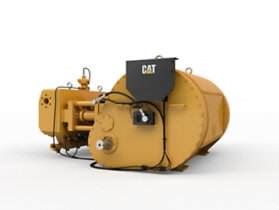
The Internet of Things
The Industrial Internet of Things is also ensuring that industrial companies are able to monitor the health of their pumps through sensors embedded inside the pumps. Another company pioneering the Product Lifecycle Management (PLM) for pumps through the Internet of Things is a company named ThingWorx.
Their virtual representation solution is able to show when air bubbles are forming and causing cavitation.

“Using our technology and integration with analytics tools we can take these actual values and we can pump them into a computational fluid dynamics simulation so we can see problems. We can actually use that data to perform not an idealized simulation, but visually represent what’s actually happening in the pump right now,” said Michael Campbell, Executive Vice President of PTC’s ThingWorx IoT platform.
They hope one day to implement augmented reality on physical hardware so that operators can ‘see’ what is ailing a piece of machinery in real time.
When cavitation occurs high strength material is damaged by collapsing bubbles, and as a result microcracks are formed. In the past it was almost always impossible for operators to notice this process in enough time to avert an expensive shutdown of operations - the most likely outcome. With increasingly sophisticated virtual representations of the inner workings of pumps, the job of monitoring has become more effective, allowing operators to more easily pre-empt trouble and damage.
“What we would like to do, where we’re headed, is being able to present this on the pump itself in augmented reality so you can look at it and see what’s happening. You’ve seen a wind tunnel where they introduce smoke so you can see what the airstream is doing? Augmented reality is similar,” Campbell said.
Through immediate data and analytics of the operation of pumps within an industrial operation, those costly shutdowns could be a thing of the past.
Works Cited
"ThingWorx Analytics - Flowserve Pump Demo." YouTube. 01 Aug. 2016. Web. 17 May 2017.
Waters, Louise. "Caterpillar Launches Pump Electronic Monitoring System at OTC." Oil Review Middle East. Web. 17 May 2017.
- Details
- Written by: Quintus Potgieter
Robots are an integral part of the industrial operation, and as the fourth industrial revolution steamrolls ahead, they are part of the automation of more and more processes than ever before.
The reality is that robots cannot be kept apart from the human worker as in years gone by. In industrial operations it is becoming commonplace to see employees interacting with and utilizing industrial-scale and smaller, collaborative robots.
Collaborative robots are robots specifically designed for repetitive tasks, especially menial tasks such as picking-and-placing. The concern for those employed to do such duties is that they are now replaceable.
And robots are only getting smarter thanks to artificial intelligence.

The growth of automation
In the United States, the National Academies of Sciences, Engineering and Medicine have, at length, studied the effects of information technology and automation in the workplace. They realize that the rise of automation is an unstoppable force that is driving production up and redefining what the world considers ‘work’.
The group summed their research up in their white paper entitled, Information Technology and the U.S. Workforce: Where are we and where do we go from here?
Advances in IT are far from over, and some of the biggest improvements in areas like AI are likely still to come. Improvements are expected in some areas and entirely new capabilities may emerge in others.
These advances in technology will result in the automation of some jobs, the augmentation of workers’ abilities to perform other jobs, and the creation of still others.
The recent increase in income inequality in the United States is due to multiple forces, including advances in IT and its diffusion, globalization, and economic policy.
IT is enabling new work relationships, including a new form of on-demand employment.
As IT continues to complement or substitute for many work tasks, workers will require skills that increasingly emphasize creativity, adaptability, and interpersonal skills over routine information processing and manual tasks.
- Policy makers and researchers would benefit significantly from a better understanding of evolving IT options and their implications for the workforce.
The American Society of Mechanical Engineers, however, maintains that there will always be physical human input. They write:
“Most products still require some sort of human input in their manufacture. Some tasks require physical dexterity and agility but many others require the flexibility and intellectual reasoning which a robot is not yet able to supply.”
The necessity of retaining personnel alongside robots and within automated environments means that there needs to be increased cognizance of employee safety in the work place.
Safety and ethics
In a book by S.R. Fletcher and P. Webb they analyze the revelations from the 2015 International Conference on Robotic Ethics. They reckon that future robot design must factor in the protection of personnel. The writers go further, recommending that the robot operators receive thorough education about the machines so that trust between human and robot can be established. They write:
“The ethical implications of these new expectations have not yet been sufficiently explored and understood. It has also been discussed that, as a result of safety measures, manufacturing workforces are accustomed to a prevailing concept of robots in manufacturing as a hazardous and segregated from their workspace, but due to impending advances in human-robot collaboration workers will need to adapt their beliefs to accept and trust in system safety.”
Some of these steps are indeed being taken, as Engineering.com reported from a collaborative robot expo. They outlined to what extent sensory fail safes have been implemented into collaborative robots. With interconnected sensors, collaborative robots are now able to tell when a human is in its space, and can abort its operations so that operators do not get harmed.
The fourth industrial revolution will have a more subtle and potentially threatening impact on the future of the industrial operation. It will be responsible for the monitoring of both machine and worker - accumulating a great deal of data. This will include the performance indicators from both robots and humans. The results will clearly reveal which of these is working more efficiently and which is more disposable - from the company’s perspective and in terms of productivity.
Fletcher and Webb ask a very pertinent question about the interconnected, Industrial Internet of Things-esque - the performance monitoring that companies are beginning to engage in. They ask: “To what extent will data on individual performance be gathered and appraised?”
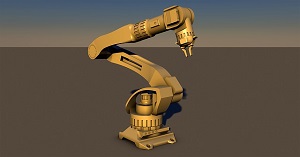
Companies, therefore, have a plethora of new ethical considerations that will form part of their company’s business human resources structure. Not only companies, this will also extend to governments. The European Union is on the forefront of developing standards for industrial robotics.
Safety standards for collaborative industrial robots exist and are constantly being updated. The current standard is named ISO 10218, which covers: “Safety of Industrial Robots” Part 1: “Robots” and Part 2: “Robot systems and integration.” In the coming months and years, more robotics standards will be embedded into law to ensure that the right steps are taken for collaborative robots and humans to work safely and in harmony.
Contentiously, one does wonder if the future will require this particular set of standards?
Works Cited
"The American Society of Mechanical Engineers." ASME.org. Web. 15 May 2017.
ENGINEERING.com. VIDEO: Collaborative Robot Safety with Immediate Contact Stop Features ENGINEERING.com. Web. 15 May 2017.
Isabel, Aldinhas Ferreira Maria, Joao Silva Sequeira, Mohammad Osman. Tokhi, Endre E. Kadar, and Gurvinder Singh. Virk. A World with Robots: International Conference on Robot Ethics: ICRE 2015. Cham: Springer International, 2017. Print.
National Academies of Sciences, Engineering, and Medicine; Division on Engineering and Physical Sciences The National Academies Press. 16 Mar. 2017. Web. 15 May 2017.
- Details
- Written by: Quintus Potgieter
If companies want to capitalize on the future of clean energy, they’re going to have to get at least one foot in the door when it comes to storing that energy. A company who has a little more than a foot in the door is Tesla. It has been in their interest to invest in lithium-ion battery technology because the Tesla business relies on it: electric vehicles and solar storage for homes and businesses. They have made strides in growing their batteries’ lifetimes thanks to a seasoned battery researcher named Jeff Dahn.
Dahn has been working for Tesla for over a year now and has professed that the batteries tested in Tesla’s labs have achieved double the lifetime of Tesla’s previous cells. He signed on with Tesla in June 2015, for a five-year tenure, during which time he is working with researchers on making Tesla’s lithium-ion technology the envy of the industry.
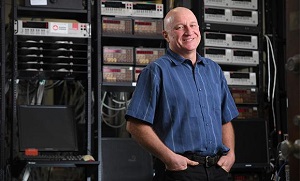
Credit: Dalhousie University
The progress they have made is thanks to the discovery of a variation of an aluminium coating on the cells that “outperformed” other materials. Dahn is now traveling to prestigious universities, one being the Massachusetts Institute of Technology, to showcase the new cells to students. The cells, according to Electrek, “showed barely any degradation under high numbers of cycles at moderate temperature and only little degradation even in difficult conditions.”
At MIT, Dahn recapped the events pertaining to the project of developing energy-dense batteries for Tesla and how they had made their most recent discovery. He said:
“In the description of the project that we sent to NSERC (Natural Sciences and Engineering Research Council) to get matching funds from the government for the project, I wrote down the goal of doubling the lifetime of cells used in the Tesla products at the same upper cutoff voltage. We exceeded that in round one. OK? So that was the goal of the project and it has already been exceeded. We are not going to stop - obviously - we have another four years to go. We are going to go as far as we can.”
The Manganese Nickel Cobalt batteries that Dahn is specializing in are specifically for Tesla’s home-based Powerwalls and the utility-scale Powerpacks that are available to businesses. He says that there is no reason why the batteries cannot last for 20 years.
Naturally, Dahn is being tight-lipped on the progress they are making and is not giving too much away in terms of the chemistry behind their discoveries.
However, more will be made clear as Dahn and his team of researchers continue to grow the energy density of Tesla’s cells.

Credit: Electrek
Dahn has said that he is in the business of building more efficient batteries because the planet needs an alternative to fossil fuels. In an interview with his university’s website he said:
“We can’t just keep burning fossil fuels; we’re going to heat the planet into death. And if you want to continue to have land that is not submerged, you have to do something about it.”
Works Cited
Lambert, Fred, and John Fitzgerald Weaver. "Fred Lambert." Electrek. 10 May 2017. Web. 11 May 2017.
McNutt, Ryan. "Supercharged Success: Battery Researcher Jeff Dahn Wins Herzberg Gold Medal." Dalhousie News. 07 Feb. 2017. Web. 11 May 2017.
- Details
- Written by: Quintus Potgieter
Elon Musk owns many companies that are on the cutting edge of engineering and business endeavor. Most recently he has been working on Mars missions and relaunching used rockets with his company SpaceX. He also designs, manufactures and sells electric cars and solar storage options through Tesla. But now he is boring. He has even named it the Boring Company.
His new company has begun digging a tunnel below SpaceX’s parking lot in Los Angeles. The boring machine, that has arrived and has been put to work, is reportedly working at a speed slower than a snail - literally. Musk intends to create a system of tunnels to transport traffic, to eliminate the nuisance all cities are starting to experience due to population growth: congestion. In a new TED Talk Interview held on the 30th of April 2017, Musk was asked why he was boring. He said:
“We’re trying to dig a hole under L.A. This is to create the beginning of what will hopefully be a 3D network of tunnels, to alleviate congestion. Right now, one of the most soul-destroying things is traffic, it affects people in every part of the world, it takes away so much of your life and it’s horrible.”

The Boring Company’s boring machine
Source: Electrek
Cars will be lowered underground on what Musk calls a ‘car skate’ and they will then ‘skate’ 124 miles per hour to their destination, under the ground. The Boring Company has released an animated video that gives a better idea of how the system might work within the cities of the future:
Musk said:
“You have to be able to integrate the entrance and exits of the tunnel seamlessly into the fabric of the city. By having an elevator - sort of a car skate that’s on an elevator - you can integrate the entrances and exits to the tunnel network just by using two parking spaces.”
Futurologists vs Futurologists
Musk discounts the rumors put about by the critics who say that drilling underground will be hellishly disruptive to normal life above ground. He says that earth absorbs vibrations very expertly the deeper you go. And they plan on going deep. Some writers and futurologists, on the other hand, are theorizing about the future of flying technology - integrating flying cars into the city in an effort to minimize congestion. Musk, however, is persistently boring.
He said:
“There’s no real limit to how many levels of tunnel you can have, you can go much further down than you can go up. The deepest mines are much deeper than the tallest buildings are tall. So, you can alleviate any arbitrary level of urban congestion with a 3D tunnel network.”
Musk explains why he is against a future where flying cars ease congestion: the wind force, the noise generated by flying traffic and the chance that car parts might rain from the sky, would elevate human anxiety levels. And it is this anxiety he is hoping to alleviate.

Works Cited
"Elon Musk's TED 2017 Full Interview." YouTube. YouTube, 30 Apr. 2017. Web. 05 May 2017.
Lambert, Fred, and Fred Lambert @FredericLambert Fred Is the Editor in Chief and Main Writer at Electrek. "Elon Musk’s Giant Tunnel Boring Machine Arrived at SpaceX – First Pictures." Electrek. 28 Apr. 2017. Web. 04 May 2017.
- Details
- Written by: Quintus Potgieter
“It is focused relentlessly on the national interest and assuring that temporary migration visas are not a passport for foreigners to take up jobs that could and should be filled by Australians. Australian jobs for Australian’s first - that’s the focus.” - Malcolm Turnbull

In an unexpected move, Malcolm Turnbull, the Prime Minister of Australia, has announced changes in the immigration policies of Australia. The amendment to the law stipulates that temporary visas will be outlawed for skilled overseas workers. In the past, overseas workers were able to go to Australia for up to four years. With the new, stricter system, a temporary work visa could be limited to two years.
Engineering managers, engineering technologists and environmental engineers, however, continue to be eligible to apply for four-year residencies in Australia. Whereas 200 job categories were made ineligible for a temporary work visa in the future plan. Malcolm Turnbull says:
“The 457 visa will be replaced by a new temporary visa, specifically designed to recruit the best and the brightest in the national interest. The new visa will better target genuine skill shortages, including in regional Australia. It will include new requirements, including previous work experience, better English language proficiency and labour market testing.”
The backlash against the cancellation of 457 visas is growing, however, particularly as its removal will make it difficult for migrants to become permanent citizens. Writing for The Lowy Institute’s The Interpreter, Henry Sherrell highlights how important immigration has been for Australia in the past:
“As a small, open economy, we rely on immigration more than any other major developed country in the world; over 28% of the population is born overseas. Removing the ability for many migrants to become permanent residents after spending a period of time in Australia will make it harder for employers and organizations like universities to attract global talent.”
The concern is that Australia will be less attractive to competent international higher education recruits. The category ‘university lecturer/research fellow’ was added to the Short-term Skilled Occupation List, which only allows for a two-year temporary visa. Professor Peter Høj, Vice-Chancellor and President of the Group of Eight - the group of Australia’s top research universities - spoke to the Guardian, saying:
“At face value the new technical arrangements for the temporary skills shortage visas and employer sponsored permanent skilled visas may make maintaining Australia’s international advantage more difficult. More broadly, the mere suggestion of the government clamping down on academic mobility into Australia could deter potential academic recruits to Australia.”
Turnbull’s about-turn on immigration is unsurprising when juxtaposed with President Trump’s ‘Hire American Buy American’ executive order and the UK’s Brexit negotiations. They reflect a deep dissatisfaction in these electorates as a result of higher unemployment rates. There will be collateral damage: higher education institutions, for example, will be impacted if top-tier researchers, professors and even students are dissuaded from taking up international positions.
Works Cited
"457 Visas: All Australia Had to Do Was Hold the Line." Lowy Institute. Web. 28 Apr. 2017.
Doherty, Ben. "Universities Fear 457 Visa Changes Will Harm Ability to Attract Academic Talent." The Guardian. Guardian News and Media, 19 Apr. 2017. Web. 28 Apr. 2017.
- Details
- Written by: Quintus Potgieter
In our modern world engineers are tasked with finding and designing solutions to the key challenges that population growth poses. Building vital infrastructure, which does not harm the planet, for an ever-growing global population is one of the most important challenges engineers face today.
There is one thorny problem to overcome before sustainable solutions can be found:
Our linear economy is impeding the sustainability of engineering invention and manufacturing. Hence, an economic concept, relatively new to the world, has been introduced that is already impacting and changing engineering. It is called the circular economy.

The Institution of Engineering Technology reports that by 2030, there will be 3 billion more middle class consumers. And by 2050, there will be 10 billion more people on the planet.
What does this equate to in infrastructural terms? More waste, and more water consumption. The institution says that waste levels are currently at 3.5 million tonnes a day, and by 2050, humans will be generating 10 million tonnes of waste per day.
David Rakowski, a systems engineer for the PA Consulting Group, is an expert on the topic of the circular economy. He compiled the aforementioned figures and says:
“It doesn’t take a genius to realize that the legacy we’re leaving our children is quite simply unsustainable. But why is that? Well, if you look at our current approach, we take a linear model. We dig something out of the ground, we turn it into something, and then we throw it away. That clearly isn’t going to work in a world of finite resources. So, is there another way? Well, what if, instead of taking something out the ground, making something and disposing of it, we recycled, remanufactured and reused it? It’s not exactly rocket science. But this is the fundamental concept behind the circular economy.”
Starting with waste
Engineers can, through technical intervention, create solutions for a circular economy – an approach which can work across engineering disciplines. The concept of the circular economy, however, has come under some criticism. There may be a willingness to implement the changes, but the vagueness surrounding the concept is creating a barrier. This is much like the fourth industrial revolution; some could get left behind because there is a lack of clarity on how to proceed.
In Delphine Gallaud and Blandine Laperche’s book: Circular Economy, Industrial Ecology and Short Supply Chain, the authors shine some light on how the circular economy impacts engineering. They believe that evidence of circular economy engineering emerges first in cities and neighborhoods.
They report that new industrial models are being built around the circular economy:
“These include reuse, repair, recycling, functional economy, eco-design, industrial ecology, sustainable supply and responsible consumption, in other words a profusion of concepts which demonstrates that the definition of circular economy has not yet stabilized completely.”
The circular economy is defined by how long resources can be kept and used - the hope is that resources can be kept and reused for as long as possible. It is also known as the zero waste economy. However, generating waste is almost unavoidable in industrial situations. But engineers must think how to eliminate waste, or alternatively, use that waste to create something else.
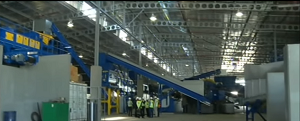
In Cape Town, South Africa, engineers have opened a waste to energy plant. The plant will utilize the household, municipal, and industrial waste the city generates and turn it into a usable fuel (liquid petroleum). The plant cost the city USD$32 million.
The plant will receive 500 tons of organic household, municipal, and industrial waste per day. It is expected to create 80 job opportunities and reduce the number of landfills in Cape Town.
The city is also collaborating with a project known as the Waste Industrial Symbiosis project that will reportedly find a use for the waste of the waste that their processes of turning garbage into liquid petroleum produces. These are the ways the circular economy is beginning to change how engineers utilize plastics and other wastes.
This process of turning engineering into an ecosystem which utilizes everything that flows through it is known as industrial ecology, and is something that engineers must consider in the future of their industrial operations - using waste as a resource. As a result a linear system becomes a closed loop system, and thereby, far more sustainable.
Works Cited
"Circular Economy." World Economic Forum. Web. 08 May 2017.
"Engineering the Circular Economy." YouTube. 29 Oct. 2015. Web. 08 May 2017.
Gallaud, Delphine, and Blandine Laperche. Circular Economy, Industrial Ecology and Short Supply Chain. London: ISTE, 2016. Print.
- Details
- Written by: Quintus Potgieter
The United Nations’ State of World Cities report in 2013 estimated that the number of urban residents around the world would grow by 60 million yearly. They also predicted that more than 60% of the world’s population would be living in smart cities by 2050. To accommodate this large influx of human beings, the world’s cities don’t necessarily need to become bigger - they just need to become smar
ter. The opportunities for engineers in the Smart City boom are immeasurable.

A book by Renata Paola Dameri named Smart City Implementation: Creating Economic and Public Value in Innovative Urban Systems defines what the smart city should aspire to in the 21st century:
“A smart city includes all the aspects of the urban life; from tourism to commerce, from industry to agriculture, including logistics, research and education. A smart city program impacts on all the urban infrastructures: public and private buildings, factories and transport facilities. A strong information and communication infrastructure should support knowledge management in the urban context and the sustainability of a smarter city could positively affect water, energy and mobility.”
The book also makes light of the fact that it is impossible for one smart city to resemble another smart city entirely. Depending on the government of the day, municipalities are looking to implement several different technologies in several different ways, based on what they have at their disposals.
Chinese standards for Smart Cities
Chinese telecoms company Huawei believe they can implement technologies to set a standard for smart cities in the future.
Huawei are working with the Indian government to potentially kick-start the Indian smart city initiative. They will target the power utilities first - the company intends to build smart grid solutions for India’s energy sector. They will do this through their Advanced Metering Infrastructure (AMI) solution. Derek Hao, President of Huawei India said:
“In the past, employees had to go to households to collect meter data once a month. Problems including inaccurate metering, ineffective power theft prevention, long charging periods, and inaccurate line loss calculation often causing high O&M (operation and maintenance) utility costs.”
Huawei’s AMI solutions are an agile system that can monitor electricity usage and generate data for power utilities. Huawei uses a product they have developed known as the Hi-PLC. Smart metering of more than 10 million terminals can purportedly be done through this system. “It can greatly help a power utility company reduce electricity loss and increase meter reading efficiently,” Hao said.
The company had generated a handsome USD 75 billion as of 2016. They confirmed this year that they would be offering similar assistance to over 100 smart cities in over 40 countries.

More work to be done
Sanjay Samra, a Professor of Mechanical Engineering at MIT, spoke to ZDNet saying that in their current state, cities are still falling short of the ‘smart city’ moniker. He said:
“Cities today are rather dumb. A significant portion of traffic is just drivers ‘cruising’ while they look for parking, street lights are often on when they are not needed, water systems lose upwards of 50% of the total supply to leaks and the electric grid is incapable of truly responding to new technologies such as electric vehicles and solar panels. Smart parking meters, connected street lights, instrumented water supplies, and smart grids will reduce traffic, save energy, save water, and make the grid more friendly to renewables. ”
Current and future engineers will be tasked with building sustainable infrastructure that is digitally enabled, granted the funding to build the infrastructure is there. That is something that PriceWaterHouseCoopers Global Advisory Leader, Miles Everson, spoke about at the Digital Revolution Summit Mobile World Congress 2017.
Works Cited
Brown, Eileen. "Although Smart Cities Rely on IoT, Security Confusion Still Reigns." ZDNet. ZDNet, 25 Apr. 2017. Web. 25 Apr. 2017.
Dameri, Renata Paola. Smart City Implementation: Creating Economic and Public Value in Innovative Urban Systems. Cham: Springer International, 2017. Print.
Www.ETTelecom.com. "Huawei Keen on India's Smart City Project: Official - ET Telecom." ETTelecom.com. 20 Apr. 2017. Web. 25 Apr. 2017.
- Details
- Written by: James Mackay
- Details
- Written by: Quintus Potgieter
Virtual labs
Remote engineering, also referred to as online engineering, is a fairly recent development in engineering and science. Its aim is to facilitate the shared use of equipment, resources, and specialized software such as simulators.
The expansion of the internet as a tool for training and actual work has thrust remote engineering into a position of importance. The world of engineering is after all a connected world; every engineering component is connected to a computer and therefore the internet. PLCs, oscilloscopes and 3D printers are good examples.
This connectivity has allowed engineering departments to reduce their requisite on site laboratory equipment which underpin the theory given to students.

And this is just as well: the range of required engineering tools is growing exponentially, and then changing in pace with technology. Educational facilities are able to scope out what the latest in technology demands, but obtaining it all is often out of their reach or just impractical. Instead, the advance of the Internet of Things and engineering equipment simulation software are transforming the traditional engineering labs and making it all accessible from the cloud.
Online engineering is fast developing the infrastructure for the facilitation of remote access for engineering technologies. These virtual simulations mean that engineering trainees and graduated engineers all across the world have opportunities to access these technologies and up-skill.
With the changing face of higher education, and continued professional development in engineering, the interest in and need of virtual laboratories and remote services is being realized.
Where does it fit into the future of education?
Annually, the International Conference on Remote Engineering and Virtual Instrumentation is held to discuss progress in the industry.
The conference was started in 2004, when virtual instrumentation was largely a foreign concept. However, 13 years later, cyber-physical systems are gradually being added to universities’ and companies’ training and design arsenals. The accessing of simulation software and virtual playgrounds for engineering students is no longer fiction.
Dr Russ Meier, a Milwaukee School of Engineering Distinguished Teaching Professor delivered a keynote in the 2016 edition of the conference. His keynote was entitled: Flipping the Classroom, the Laboratory and Social Media with First Year Engineering Students.
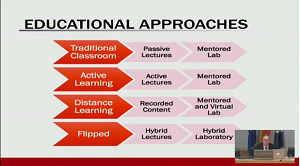
He said that a passive lecture in a large lecture hall is a dying methodology. The complete opposite of passive lectures would be a flipped classroom where hybrid lectures and hybrid laboratories are available to students.
(‘The flipped classroom is a pedagogical model in which the typical lecture and homework elements of a course are reversed. Short video lectures are viewed by students at home before the class session, while in-class time is devoted to exercises, projects, or discussions.’)
Meier also said that, “Virtual laboratories are an integral part of the distance learning experience.”
He asserts that wider development, distribution and application of online engineering technologies are needed. Meier believes that remote interaction between members of the educational community (teacher and students) is essential in this model.
Not only does the development of these tools have an effect on how we train prospective engineers, but it also revolutionizes the way engineers do their jobs.

Simulation + design = faster designs
The effectiveness of virtual labs is further strengthened once it involves a mix of virtual and augmented reality technologies.
Microsoft’s Hololens is the first working prototype evidence that engineers, in the very near future, will be able to collaborate on projects with Virtual Engineering Labs.
The implementation of this sort of technology could reupholster the methods universities and companies use to train their staff. Instead of cumbersome, physical labs which quickly date, an investment in on hardware and software packages could fit the needs of the business.
The company now has six virtual labs in Wolfsburg, Berlin, Munich, Barcelona, Shanghai and San Francisco.
The head mounted ‘goggles’ will be utilized to design future models of VWs, according to Frank Ostermann, a computer engineer at Volkswagen Group IT. Speaking to MSPowerUser. He said:
“At Volkswagen, we have been using augmented reality and virtual reality for some time, mainly to obtain a three-dimensional view. We are now taking a major step forward at the Virtual Engineering Lab. We are transforming technology into a tool for Technical Development.”
Ostermann says the technology leads to faster decision making by the engineers. He also says the software will, in future, be used for both testing out fully virtual components and for the testing of a component through virtual representation on top of a physical object.
Works Cited
"Conferencia REV2016 - 13th International Conference on Remote Engineering and Virtual Instrumentatio." Canal.uned.es. Web. 18 Apr. 2017.
"Volkswagen's Virtual Engineering Lab Using Microsoft's HoloLens to Design Their Future Cars." MSPoweruser. 30 Mar. 2017. Web. 18 Apr. 2017.
- Details
- Written by: Quintus Potgieter
Proof that adding ‘googly eyes’ to your next engineering design will improve customer satisfaction is here. In Baltimore, Maryland, in the United States, engineers have added eyes to a solar powered, trash-eating water wheel. They have subsequently given it a name as well: Mr Trash Wheel.
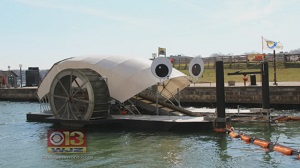
Image Credit: CBS News Baltimore
The creators of Mr Trash Wheel explain how it works on their website: “The river’s current provides power to turn the water wheel, which lifts trash and debris from the water and deposits it into a dumpster barge. When there isn’t enough water current, a solar panel array provides additional power to keep the machine running. When the dumpster is full, it’s towed away by boat, and a new dumpster is put in place. Voila!”
Since the beginning of the water wheel’s operation in 2014, it has collected and cleared 550 tons of trash from Baltimore’s Inner Harbor. It collects 38,000 lbs of garbage a day.
The engineer behind the trash wheel, John Kellet, says that the water wheel could contribute to lowering the amount of plastic that is finding its way into the ocean.
Natural order of things
Using the natural order of things, Mr Trash Wheel uses the natural river currents to funnel trash toward its gaping mouth. This is something that engineers are trying to harness and use to their benefit around the world. An organization leading the charge of cleaning up the plastic in the ocean, with natural ocean currents, is a company named the Ocean Cleanup Project. Read more about them here.
The natural order of things is unfortunately what causes the garbage problem to begin with. Kellet laments that when it rains in Baltimore, the rain water transports litter into the watershed that then feeds the litter into the river - and then into the sea. This is an issue that all coastal regions in the world face today.
Engineers + social media = fun
One of the novel approaches to spreading awareness of their project was first to give the contraption its own name. Fast forward a couple years, and now, it even has its own beer. Mr Trash Wheel’s Lost Python Ale was coined after the engineers found a West African ball python in the trash wheel. The engineers had 15,000 cans brewed. 25% of the proceeds will go to keeping Mr Trash Wheel running.
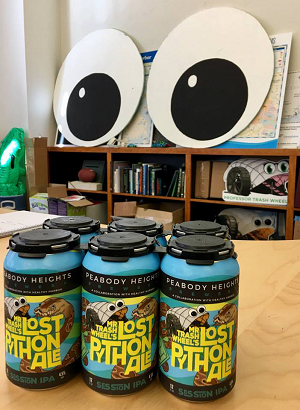
A social media account is also establishing a social presence for the character that is Mr Trash Wheel, and adds to his likeability and his human likeness. Follow him on Twitter for more updates: @MrTrashWheel
Furthermore, getting children excited through the character, teaches environmental responsibility, and it could spur them on to become future engineers who develop technologies that might benefit the planet. Just like Mr Trash Wheel!
Works Cited
"Mr. Trash Wheel Now Has His Own Beer, Proceeds Will Help Clean The Harbor." CBS Baltimore. Web. 23 Apr. 2017.
- Details
- Written by: Quintus Potgieter
“It’s a big problem this place. I’ve lost a lot of money. I lost about a million five years ago. So, I stopped for five years. I learned a lesson. Why did they build this place here? To give money away? They’re here to make money. It’s not to give you money. ” - Anonymous.
“All that the capital city needed and more! Pretty awesome.” - Facebook commenter.
These were the mixed reactions to Africa’s second-largest casino. Sun Times Square, a casino that cost USD$289 million to build, opened its doors on the first of April 2017. A monument to capitalism erected in the city of Pretoria, a city that is regenerating and renovating using current civil engineering practices. It promises to be a hotbed of social activity thanks to these endeavours.

In the construction phase of the casino, 10,000 jobs were created, and upon completion, 2,200 permanent jobs will remain. An 8,500 seat arena and a hotel are also being constructed. The casino, however, is open for business.
The casino has 2,000 slot machines with the latest in engineered gaming technology in its arsenal, and there are 100 tables set out for run of the mill card games, roulette, etc.
Our skills for sale – for better or for worse
Natasha Dow Schull, a cultural anthropologist and professor at Massachusetts Institute of Technology (MIT) published a book in 2012 entitled: Addiction by Design: Machine Gambling in Las Vegas. She outlines how modern day slot machines came to be. She writes:
“This process involves up to three hundred people, including script writers, graphic artists, marketers, mathematicians, and mechanical, video, and software engineers -- not to mention designers of auxiliary components like touchscreens, bill validators, and machine cabinets.”
Slot machines are basically just random number generators. In 1993, all slot machines were microprocessor driven. Now, they are linked via interconnected networks that are plugged into a central server, with unprecedented data-gathering technology that also monitors players.
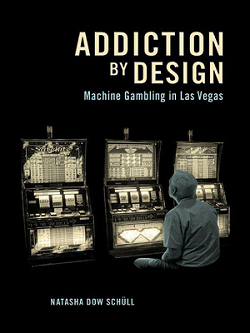
The modern slot machine is carefully engineered against the players. They are warned, but still struggle to resist the lure of possible winnings.
In the 1970s revenue figures for casinos in the United States revealed that 50% or less was garnered from the slots. And now, despite those warnings, gaming machines are responsible for between 70 and 80% of their revenue; they are becoming more popular.
It’s modernized, but is it fair?
In 2010, The American Gaming Association (AGA) issued a white paper named: Demystifying Slot Machines and Their Impact in the United States. The company wrote that slot manufacturers “need to build devices for a society with a decreasing attention span and an increasing demand for exciting, fast-paced entertainment, all in a marketplace overflowing with competing entertainment options.”
Little is said about how they are pitted against the players, but much about how they can be upgraded to reflect the advances in technology of the modern world.
Gone are coins and paper-money slot machines. Gambling machines in modern casinos now work on credit card-like technology, utilizing magnetic stripes with informational data, unique to each gambler, stored on them.
Another shift in design, for ease of use, is the touch screen in place of the lever. And the reels that usually housed the numbers have been replaced by digitally displayed graphics.
The modernization of the gambling machine will only become more powerful as the fourth industrial revolution plods along: the Internet of Things and 5G-connected technologies. It will increase a casino’s ability to monitor its risk, against that of the player.
Schull concluded that it is no longer about risk or volatility with slot machines. It is simply an engineered algorithm which the players believe may just work in their favour and which offers a pleasant diversion and distraction. She said:
“When you look at contemporary slot machines, they don’t operate on volatility. One designer of the mathematics and algorithm of these games said we want an algorithm that makes you feel like you are reclining on a couch.”
Mitch Hedberg, an American stand-up comedian, is recorded as saying, “I like to play blackjack. I'm not addicted to gambling. I'm addicted to sitting in a semi-circle.” The humor is not lost, but the designers of these gaming machines seem to be on a winner with players finding them increasingly tantalizing and irresistible.
Works Cited
Schüll, Natasha Dow. Addiction by Design: Machine Gambling in Las Vegas. Princeton: Princeton UP, 2014. Print.
Thompson, Andrew. "Slot Machines Perfected Addictive Gaming. Now, Tech Wants Their Tricks." The Verge. 06 May 2015. Web. 11 Apr. 2017.
https://www.brainyquote.com/quotes/keywords/gambling.html
- Details
- Written by: Quintus Potgieter
Space travel is heating up again. The tongue-in-cheek way people are choosing to treat this new boom in space pioneering, is by calling it the second space race. Except this time it’s billionaire versus billionaire. Business giants like Virgin’s Richard Branson and Amazon and Blue Origin’s CEO, Jeff Bezos, are looking to the skies, and hoping to define the future of space travel. Another one of the esteemed gentleman at the helm of the new age of space travel is South African born Elon Musk.
Musk famously said: “If one can figure out how to effectively reuse rockets just like airplanes, the cost of access to space will be reduced by as much as a factor of a hundred. A fully reusable vehicle has never been done before. That really is the fundamental breakthrough needed to revolutionize access to space.”
SpaceX recently achieved the breakthrough and have made aerospace engineering history by reusing a previously launched, refurbished rocket. The company sent the rocket into orbit and brought it back down to land, on a drone barge in the ocean. The rocket in question was SpaceX’s Falcon 9. It retained its original engines and components and delivered a satellite for company SES at a fraction of the price.
Reusing rockets will minimize the costs of future rocket launches, and save money on engineering rockets from scratch. SpaceX says the majority of the price of a rocket launch is the building of the rocket itself. Prices will be driven down if the reusability technology becomes commonplace in the aerospace industry.
After a USD$1 billion investment and fifteen years in the making, SpaceX was ready to launch a previously launched rocket into orbit, and bring it back down again. SpaceX’s President, Gwynne Shotwell, says that they are just getting started:
“Looking forward for reusability, we don’t believe it really, really counts unless you can turn it around rapidly, or almost as rapidly, as you turn around an aircraft. Our challenge right now is to refly a rocket within 24 hours. That’s when we’ll really feel like we’ve got reusability right.”
According to Popular Mechanics, the Russian government was initially undecided on reusable rocket technology unsure it would turn a profit for their aerospace giant, Roscosmos. However, after the success SpaceX achieved, they are now reconsidering.
The Chief of Roscosmos Igor Komarov said: “The innovations SpaceX is making are forcing us to work on lowering the cost and raising the product quality. We are running pilot projects in the sphere of retrievable components.”
The Russians risk being left behind in this Space Race 2.0, if they don’t start acquiring the engineering skills necessary to engineer reusable rockets. SpaceX and America’s space authority NASA are linking arms to take another giant leap for mankind and take crafts to Mars by 2020. SpaceX have also said that they would be flying two tourists to the moon in 2018.
The reusing of already engineered components is a philosophy that is seldom tried so remains largely untested. However, electric vehicle (EV) companies, like Musk’s Tesla Motors, are testing their already engineered hardware for reuse. And some headway has been made elsewhere.
Reusable batteries for cars and homes
For quite some time now, car companies working on the implementation of electric vehicles on our roads, purported that once a car-powering lithium-ion battery had served its purpose within an electric vehicle (in accordance with electric vehicle standards), it could be taken out of the car and used as a home-powering energy storage device afterward.
According to experts in the field, the lithium-ion batteries in electrical vehicles still retain 70% to 80% of their energy storage capacity after they reach the end of their legal life cycle inside the vehicles. The idea was that once the battery had been used in the vehicle and was ready for decommissioning, it could be added to a photovoltaic solar array and be used to store the energy produced for the electricity used to power a home during peak demand times.
General Motors realized in 2016 that a 2012 Chevrolet Volt that had driven 300,000 miles had no battery degradation issues – a clear sign that the battery could be reused outside of the vehicle.
“Even after the battery has reached the end of its useful life in a Chevrolet Volt, up to 80 percent of its storage capacity remains,” said Pablo Valencia, GM’s senior manager for Battery Life Cycle Management.
However, a new report by Lux Research, an independent research and advisory firm in the United States, claims that recycling the lithium-ion batteries, instead of reusing them, is the best way forward for the automotive industry. An excerpt from the report read:

“Reuse of batteries from electric vehicles will deliver questionable returns on account of reduced performance, limiting them to application with less frequent and shallower depth of discharge cycles.”
Christopher Robinson, Lux Research Associate and the author of the report named ‘Reuse or Recycle: The Billion-Dollar Battery Question’, said:
“With present technology, recycling old batteries for new materials is the more economical option for creating the most value from existing materials. That said, innovations in areas like packaging and testing could tip the balance in the future, so companies should have plans for both recycling and reuse.”
BMM and Nissan both recently announced that their respective electric vehicles would be able to reuse the batteries as home energy storage systems in the near future. However, Lux Research cautions that the companies need more efficient testing, sorting, and repackaging than that which has already been advertised. Robinson says that second-life systems or the EV battery to wall systems, offer only limited cost savings and not much else.
However, BMW’s Manager of Connected eMobility Cliff Fietzek asserted that people could power their homes for 24 hours with the decommissioned batteries from their i3 EV car models. He said:
“It doesn’t make sense to scrap the battery at the end of the useful life of the car because it’s still good for services like powering your home. The car battery may be over designed for a home storage system, but well suited.”
Works Cited
Grossman, David. "After SpaceX's Success, Russia Wants a Reusable Rocket Too." Popular Mechanics. 04 Apr. 2017. Web. 06 Apr. 2017.
"Recycling, Not Reuse, Is the Better Choice for Batteries from Retired Electric Vehicles." Recycling, Not Reuse, Is the Better Choice for Batteries from Retired Electric Vehicles | Lux Research. 22 Nov. 2016. Web. 06 Apr. 2017.
Shanklin, Emily. "Reusability." SpaceX. SpaceX, 23 Mar. 2013. Web. 06 Apr. 2017.
- Details
- Written by: Quintus Potgieter
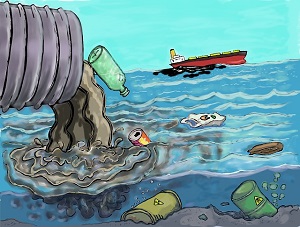 A grim reality the world has had to face in the modern age is the fact that the planet’s waterways are overwhelmingly polluted. Much of it is unfortunately thanks to the technologies and products engineered in the past.
A grim reality the world has had to face in the modern age is the fact that the planet’s waterways are overwhelmingly polluted. Much of it is unfortunately thanks to the technologies and products engineered in the past.
Humans need to put their waste somewhere; most of the time it is the ocean that gets the tough task of handling it all.
The National Ocean Service at the U.S. Department of Commerce reports that most ocean pollution begins on land. In fact, 80% of pollution that is prevalent in the marine environment comes from land, the group says. The biggest contributors are from nonpoint sources. The group writes:
“Nonpoint source pollution includes many small sources, like septic tanks, cars, trucks, and boats, plus larger sources, such as farms, ranches, and forest areas. Millions of motor vehicle engines drop small amounts of oil each day onto roads and parking lots. Much of this, too, makes its way to the sea.”
One of the places that effluence gathers and creates visible pollution ‘soups’ is The Great Pacific Garbage Patch. The Patch is a supposed Texas-sized, floating island of marine pollutants. It is also known as the Pacific Trash Vortex. Plastics and other pollutants apparently swirl around the ocean from the West Coast of North America all the way to Japan, according to National Geographic.
The Ocean Clean-up Project
Expertise has been garnered to eradicate pollution in the ocean, initiatives that have been realised in response to concerted pleadings from environmentalist communities. The technological solutions envisioned are challenges faced by those with a bent for engineering design and involve a range of organizations.
Conventional methods of ocean clean-up have involved trawling through the oceans with nets to catch plastics and other floating pollutants. One organization developing pollution-ending technologies, Ocean Cleanup, believes this method is slow, inefficient, and in some cases harmful.
In June of 2016, Ocean Cleanup - a non-profit foundation - unveiled a prototype of their large-scale plastic catcher.

The Ocean Cleanup Project’s Prototype - Credit: YouTube.com
Boyan Slat is a 21-year-old Dutch inventor and entrepreneur and also the founder and CEO of the Ocean Cleanup project. He is behind the novel ocean-cleaning design; a design which was named one of Time Magazine’s top 25 inventions of 2015.
“Why move through the ocean, if the ocean can move through you? So, I came up with this passive system, which would allow the natural ocean currents to do the hard work for us,” Slat told an audience in a prototype unveiling.
The prototype funnels plastics and garbage into an area where it all collects in a V-shape formation barrier. The prototype prevents plastics from traversing physical barriers and targets floating plastic - on and near the surface. The organization installed the prototype in June of 2016. They are ready to peruse their findings and present arguments for the further utilization of the technology. The feasibility of the project will be calculated this year, and if successful the world will see the first placement of the plastic catcher by the end of 2017.
A spokesman for the Project commented, “Computer models showed that with a single one of those systems, deployed for ten years, we should be able to clean up about half of the Great Pacific Garbage Patch. Or more, if we were to deploy more systems.”
Prototype unveiling
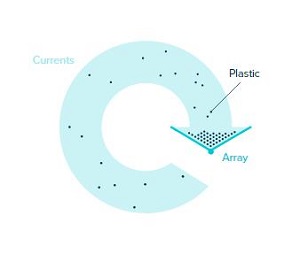
Has it lived up to the hype?
Two oceanographers, Kim Martini and Miriam Goldstein, have had their reservations about the feasibility of the technology. In an email to the Guardian, Martini wrote that Ocean Cleanup was not well read on “oceanography, ecology, engineering and marine debris distribution.”
The oceanographers are not sure the designs Ocean Cleanup have presented will be useful in capturing the volume of plastic. They felt strongly enough to offer their own review of how unfeasible the project is.
Other experts point out that it is better to trap plastic at source, instead of waiting for it to disperse across a large area of ocean. It has been estimated that it can take 50 years for plastic that has just been introduced into the ocean, to reach the Great Pacific Garbage Patch.
The Guardian reports that 19 billion pounds of plastic will make it into our oceans this year alone. Further engineering innovation is needed to nip the problem in the bud.
Lapping up the oil
Cleaning up the mess resulting from engineering endeavours has also become a bone of contention, especially with offshore oil drilling operations. Oil spills are a nasty by-product of the oil industry and of great harm to the oceans’ ecosystems.
A group of science and engineering researchers at Argonne National Laboratory at the University of Chicago have presented a possible solution to minimizing the effects oil spills have on the ocean and its marine wildlife. They suggest that they could soak it up before it becomes a problem.
The researchers presented the Oleo Sponge to the internet this March; an invention which soaks up oil and petroleum products and removes them from the water.
The laboratory showed in a demonstration that the Oleo Sponge worked efficiently at minimizing prevalent oil within water, and fared better than “industry-standard” technologies. The sponge is also reusable. The researchers say they are still testing the product, but are looking for licensing partners to allow them to sell the sponge to private companies.
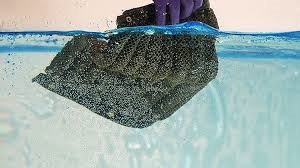
A prototype of a sponge that can be used to extract oil from water. Credit: The University of Chicago
“We already have a library of molecules that can grab oil, but the problem is how to get them
into a useful structure and bind them there permanently,” said Seth Darling, a student of the University of Chicago’s Institute for Molecular Engineering. He is one of the scientists contributing to the new sponge.
As Mary Shelley, author of Frankenstein, said, “Invention, it must be humbly admitted, does not consist in creating out of void, but out of chaos.” She may have lived before the world faced such unprecedented levels of pollution, but her words, aided by her fertile imagination, ring true.
Works Cited
"Argonne News Brief: Oleo Sponge Soaks up Oil Spills from Water." YouTube. 06 Mar. 2017. Web. 27 Mar. 2017.
"Boyan Slat Unveils The Ocean Cleanup Prototype." YouTube. 30 June 2016. Web. 27 Mar. 2017.
Kratochwill, Lindsey. "Too Good to Be True? The Ocean Cleanup Project Faces Feasibility Questions." The Guardian. Guardian News and Media, 26 Mar. 2016. Web. 27 Mar. 2017.
https://www.brainyquote.com/quotes/keywords/invention.html
- Details
- Written by: Caroline Mackay
It was the world’s worst nuclear disaster.

(The Chernobyl Disaster 2015).
The catastrophic Chernobyl disaster occurred on 26 April, 1986. Chernobyl, the nuclear power plant in Ukraine, is responsible for thousands of deaths, including large numbers of people suffering from premature cancers linked to exposure to the deadly radiation (The Chernobyl Disaster 2015).
The accident occurred during an experiment to test a way of cooling the core of the reactor in an emergency situation (The Chernobyl Gallery n.d). The reactor design was flawed and was operated with inadequately trained personnel. A chain reaction began after the reactor vessel broke during a power surge. The resulting fire carried the radioactive material into the atmosphere and spread across a vast area. The extent of the radiation can be seen below.

Radiation across Europe (Otro Mundo Es Posible 2015).
What went wrong?
Firstly, there was a deficit when it came to process control; partly explained by the fact that the plant was built for military purposes. It was designed to operate a constant loading in a plutonium production mode. Secondly, in the Soviet Union at the time the dominant philosophy invested faith in the worker - the operators in this instance (who unfortunately lacked adequate training). Automation was viewed with suspicion as it impacted on jobs (Chernobyl Did Not Need to Occur 2009).

The control room of reactor 3, not 4. (The Chernobyl Gallery n.d)
The experimental procedure was intended to run as follows:
- The reactor was to be running at a low power level, between 700 MW and 800 MW.
- The steam-turbine generator was to be run up to full speed.
- When these conditions were achieved, the steam supply for the turbine generator was to be closed off.
- Turbine generator performance was to be recorded to determine whether it could provide the bridging power for coolant pumps until the emergency diesel generators were sequenced to start and provide power to the cooling pumps automatically.
- After the emergency generators reached normal operating speed and voltage, the turbine generator would be allowed to freewheel down.
(The Chernobyl Gallery n.d.)
Prior to the accident the operators violated the plant’s technical specifications. The operators ran the plant at very low power, but without following the safety procedures (Nuclear Energy Institute 2015).
The reactors were unstable at low power, primarily owing to control rod design and ‘positive void coefficient’ factors. Without sufficient cooling for the reactors when the water levels dropped the nuclear chain reaction and power output accelerated.
Consequently, these factors all lead to an uncontrollable power surge, which destroyed Chernobyl reactor 4. This created an immediate increase in heat, which shattered a few of the pressure tubes containing fuel. The hot fuel reacted with water and caused a steam explosion lifting the 1,000-metric-ton cover off the reactor. The pressure tubes ruptured causing a second explosion which exposed the reactor’s core to the environment (Nuclear Energy Institute 2015).
The fire burned for 10 days. Deadly radioactive material escaped into the environment.
Could this disaster have been prevented?
In short, yes.
If the process controls had been properly designed, the Chernobyl disaster could have been averted. Additionally, with more able and appropriately trained operators the outcome may have been less catastrophic (Chernobyl Did Not Need to Occur 2009).
The International Atomic Energy Agency created a group known as the International Nuclear Safety Advisory Group. In its report in 1986 it supported the theory of operator error, “the catastrophic accident was caused by gross violations of operating rules and regulations” (INSAG safety report).
Overall, this detrimental accident proved that a process must be understood before it can be controlled. The most experienced control engineers would all tell you this (Chernobyl Did Not Need to Occur 2009).
Are you interested in learning more?
The Engineering Institute of Technology (EIT) have an array of engineering programs. The School of Industrial Automation, Instrumentation and Process Control is dedicated to this area of expertise, which would have been invaluable in this Chernobyl disaster. If this area is of interest, have a look at the programs offered: http://www.eit.edu.au/engineering-institute-technology-eit-school-industrial-automation-instrumentation-and-process-contro
Additionally, EIT’s Master of Engineering (Safety, Risk and Reliability) is an ideal gateway to boost your capacity to tackle these real world increasingly complex issues, specifically in; safety, risk and reliability. This carefully designed learning journey will develop factual understanding and also exercise participant’s creativity and design-thinking capabilities. Employers are hungry for these skills, and program graduates can expect a significant advantage when interacting with employers, clients, consultants and fellow engineering peers.
Gallery from the Chernobyl Disaster:

A sea of gas masks is left behind in an abandoned building (It Looks like our Planet after Humanity Disappears 2016).

An innocent child who was affected by this horrific engineering failure (Chernobyl Disaster 2013).

An abandoned park (World Remembers 30th Anniversary of Chernobyl Disaster 2016).

Looking into the reactor (The Chernobyl Gallery n.d.).
Inside Chernobyl: Rare Footage of the disaster zone. Have a watch of this YouTube video
We would love to hear from you. Please send us your comments and/or personal experiences relating to this infamous disaster.
References:
Arbor, A. 2016. World Remembers 30th Anniversary of Chernobyl Disaster. [ONLINE]. Available at: https://bhavanajagat.com/2016/04/26/world-remembers-30th-anniversary-of-chernobyl-disaster/
Alvarez, B. 2015. Otro Mundo Es Posible. Avaialble. [ONLINE] Available at: http://www.otromundoesposible.net/contaminacion-radiactiva-incidentes-en-la-industria-nuclear/. [Accessed 4 March 2017].
Bogdan. 2015. The Chernobyl Disaster. [ONLINE] Available at: http://historyconflicts.com/chernobyl-disaster/. [Accessed 1 March 2017].
Chernobyl Disaster 2013, ‘The affects to children after the Chernobyl disaster’, Twitter post, 16 October. Available at: https://twitter.com/chernobyl_facts
Grossman, P. 2014, Inside Chernobyl: Rare footage from ruins left by world's greatest nuclear disaster, YouTube video, 5 December. Available from: https://www.youtube.com/watch?v=VvH7BRubFIg
Liptak, B. 2009. Chernobyl Did Not Need to Occur. [ONLINE]. Available at: http://www.controlglobal.com/articles/2009/chernobyl0907/. [Accessed 20 March 2017].
Moore, C. 2016. It Looks like our Planet after Humanity Disappears. [ONLINE]. Available at: www.dailymail.co.uk/news/article-3556058/
Paul. n.d. The Chernobyl Gallery. [ONLINE]. Available at: http://chernobylgallery.com/chernobyl-disaster/cause/
Safety Series No. 75-INSAG-4, IAEA, Vienna, 1991. Available from: http://nuclearsafety.info/safety-culture/
2015. Nuclear Energy Institute. [ONLINE]. Available at: https://www.nei.org/Master-Document-Folder/Backgrounders/Fact-Sheets/Chernobyl-Accident-And-Its-Consequences
- Details
- Written by: Quintus Potgieter
China’s National Energy Administration (NEA) has announced that all construction projects for new coal power plants will be cancelled, effective immediately. Instead, the NEA is investing $361 billion into expanding renewable energy technologies in an effort to reduce the crippling smog levels in many cities in China. The number of coal power stations that will be halted, according to Reuters, is “over 100”.
The Independent predicts that the move from coal to renewable power will reportedly generate 13 million jobs in the renewable energy sector in China.

Credit: Pixabay.com
The job losses in the coal industry will be extensive, but the plan is to retrain these workers for the oncoming renewables revolution. The reality, however, may not be quite as clear cut or as rosy as hoped.
Australia
Australian experts seemingly have a different story to tell when it comes to renewable energy employment. The Australian Bureau of Statistics (ABS) reported that there had been a 16% drop in employment in June of 2016.
According to ABS’ research, the employment in renewable energy activities was estimated as follows:
|
Year |
No. of employees |
|
2011/12 |
19,220 |
|
2014/15 |
13,300 |
|
2015/16 |
11,150 |
Olivia Kembler, the Head of Policy at the Climate Institute said, “A 16% decline since last year, following after several years of falling job numbers, is a direct result of the government’s failure to set a national strategy for clean, modern energy. That costs us in terms of higher prices, less reliable and more polluting power, but we should also recognize it costs us in terms of the thousands of new jobs that we could have but don’t.”
However, the Minister of Environment and Energy, Josh Frydenberg, said that the figures were not wholly correct. He said that the Australian Renewable Energy Agency was about to announce developments that would lead to 2300 new jobs in the renewable industry - just as the ‘record low’ numbers were reported.
The job situation in the renewable energy sector needs to be monitored – projections of huge growth in employment have not panned out. In Australia small-scale solar installations are on the rise, not the large-scale ones. And yet it is the latter that require labour, alongside their inevitable maintenance issues.
American optimism
Researchers at Greentech Media Research, a media company that publishes daily reports on the renewable energy sector, are optimistic about the future employment prospects for the global electricity market.
They report that they have seen an annual growth of 50% across the global solar market. They have also reported on “major mergers and acquisitions in energy storage companies, and utilities spending billions of dollars in renewable energy technologies”.
The Environmental Defense Fund (EDF) reported that from 2012 to 2015, renewable energy employment figures rose by 6%. Their bolder claim is outlined in the report: ‘Now Hiring: The Growth of America’s Clean Energy & Sustainability Jobs’:
“Solar and wind jobs have grown at rates of about 20% annually in recent years and are each creating jobs at a rate 12 times faster than that of the rest of the U.S. economy”.
The Solar Foundation performed a census of Americans working in the solar energy industry and found that there had been more than 260,000 working professionals actively working in the industry. The figure was three times it was in 2010.
The important question to ask is, ‘Will jobs in the renewable energy sector be retained?’ Some argue that the key to ensuring demand for jobs in this sector continue to rise is up to the government of the day, but automation technologies may yet replace some of those which are presently using manpower.
Automation
“Substation automation, decades ago, removed the need for workers at substations to carry out hour to hour adjustments in the control settings of the grid,” A GTM Researcher told social media site Reddit during a Q&A session.
Automation has been, and will be, a force that replaces the more rudimentary jobs in the energy generation industry.
He went on to say: “Distribution automation is increasingly reducing the number of truck rolls (and with it man-hours) required to manually isolate faults in the grid. Furthermore, new customer service technologies are reducing the need for call center employees - a primary driver of costs within utility retail operations.”
Another researcher at GSM offered a comment about automation as well:
“I’d add that while automation has an effect on the solar market, most jobs scale with demand. Automation is at play in the factory, where modules, inverters, and other solar equipment are manufactured. However, selling those components and installing systems requires real people talking to customers, designing projects, and getting out in the field to build them.”
Finding a job in the green collar sector - as it is being called - has also been a question amongst engineering professionals who want to get involved with what seems like the next big thing. Experts from GTM Research say the key to finding employment in the industry is a combination of networking and ‘developing passion projects’ and showcasing your interests and abilities to future employers.
Works Cited
"Home | Environmental Defense Fund." Home | Environmental Defense Fund. Web. 20 Mar. 2017.
"We Are GTM Research, a Market Analysis Firm Focused on the Transformation of the Global Electricity Industry. AMA • R/Futurology." Reddit. Web. 20 Mar. 2017. The Australian.
http://www.theaustralian.com.au/business/technology/renewable-energy-sector-employment-falls-abs-figures-say/news-story/0d06f72f928e427f0cd983cc1910e6ee"China Halts over 100 Coal-fired Power Projects: Caixin." Reuters. Thomson Reuters, 16 Jan. 2017. Web. 18 Jan. 2017.
- Details
- Written by: Quintus Potgieter
“The future wars will be fought over water.”
Are we heading for a future where those who have the cleanest and most abundant water will be the most prosperous? As it stands, to discern which countries are first world and which are third the cleanliness of drinking water is a consideration.
To conserve clean water some have been thinking outside the box. California’s county of Los Angeles has been through a long drought so is ready to go ‘balls to the wall’ to try and save their water.
In 2015, 96 million apple-sized, black polyethylene (plastic) balls were floating in the Los Angeles Reservoir.
American news outlets ran with the story with the following headlines, from the New York Times: In California, Millions of ‘Shade Balls’ Combat A Nagging Drought. And the Washington Post reported: Plastic ‘shade balls’: The hypnotizing tool California is using to save water.
Except, the balls were never intended to be the answer to California’s drought problems. California was utilizing the balls before the drought had ever started ravaging the land. The media had failed to do its research.
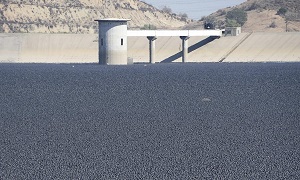
Credit: XavierC
All about chemicals
The L.A. Department of Water and Power had been introducing the plastic balls into their reservoirs since 2008. The first few were dumped into the Ivanhoe water reservoir in Silver Lake, Los Angeles.
The county had begun to notice that the UV rays of the sun were turning naturally occurring bromide into bromate. Bromate is a concern for municipal reservoirs around the world - it is a cancer-causing chemical. Silver Lake’s reservoir is especially at risk because, being uncovered, it is directly exposed to sunlight.
The balls were commissioned by the Los Angeles Department of Water and Power to counteract the sun’s UV rays and keep the water safe. Incredibly they delivered a dual benefit: they did indeed keep the water safe from bromate, but they also conserved water by reducing evaporation.
They slowed the evaporation of water and prevented the degradation of its quality, but at a cost - the shade balls cost the state USD$34.5 million, with each ball costing 36 cents. Reducing evaporation would’ve only saved Los Angeles USD$2 million per year. (But the cost savings to individuals who may have contracted Bromate inducing cancers should also be factored in.)

LADWP General Manager Marcie Edwards told NPR:
“This is a blend of how engineering really meets common sense. We saved a lot of money ; we did all the right things.”
Many reservoirs do not need to take these kinds of measures due to being covered; the ones that remain open require preventive measures so that chemical contamination does not occur.
The company that designed and manufactured them is XavierC. They specialize in the manufacturing of the “ballasted plastic conservation balls” and were well aware of their ability to slow evaporation. The company says it is a “cost effective, low maintenance solution for Cities and Municipalities”. The company says the balls should last for 25 years.
The solution is unfortunately not so neat. Richard Harasick, the director of the L.A. Department of Water and Power said that the department knew the shade balls would not be a permanent solution for reservoirs that supply drinking water to Los Angeles. Drinking water reservoirs have to be covered - shade balls allegedly do not comply with the standards needed.
The shade balls are being removed from the reservoirs in L.A. and costly coverings are being built. The shade balls do, however, remain in L.A.’s Reservoir #2 as the reservoir does not hold any drinking water.
The market for creating a technology that conserves water and presents a solution for drought- stricken areas remains.
Works Cited
Maddaus, Gene. "Shade Balls Are a Really Stupid Way to Conserve Water." L.A. Weekly. 02 Apr. 2016. Web. 28 Mar. 2017.
Wagner, Laura. "LA Rolls Out Water-Saving 'Shade Balls'" NPR. NPR, 11 Aug. 2015. Web. 28 Mar. 2017.
- Details
- Written by: Quintus Potgieter
The breakthroughs in the biomedical engineering industry were staggering in 2016. The world moved closer toward wearable systems that could continually monitor human health, and even produced studies for ingestible robots, designed to be powered by human stomach acid.
With biomedical engineering technologies becoming more apt at generating data about the human body and with more accuracy, the world is edging closer to more precise medical diagnoses.
Robert F. Graboyes, a senior researcher at the Mercatus Center at George Mason University, has said that wearable telemetry will redefine the future of doctors’ appointments. In his article, ‘Wearable Telemetry - Eating Health Care’, he writes:
“Wearable telemetry (Jawbone and Fitbit are familiar examples) is helping to overturn 2,500 years of medical tradition. For the first time, wearables offer convenient, passive, continuous monitoring of vast numbers of human bodies. Implications for the doctor-patient relationship are profound.”
Patients will be equipped with data that doctors might have to peruse, and consider, before diagnosing a patient.
However, the affordability of wearables in a time when there is still a stark gap between rich and poor highlights the need for affordable novel applications for medical diagnosis in the biomedical engineering industry.

Smartphone apps
Audiologists in South Africa are making it as wallet-savvy as possible, by installing an app on your smartphone.
“Hearing loss is considered an invisible epidemic because people don’t see it or know that someone suffers from it,” said De Wet Swanepoel, a professor of audiology at the University of Pretoria, South Africa, in an interview with the BBC.
The project that Prof Swanepoel worked on has led to the development of an app called HearScreen. All you need is your smartphone and a pair of headphones. The app uses a series of beeps that tests the hearing of the person through the headphones. Based on what they can and cannot hear, the app determines the extent of medical assistance required.
The app is not only ensuring that poorer rural communities get the diagnoses they need, but it also addresses the shortage of audiologists in South Africa.
“Mobile apps can serve a very useful role in raising awareness about hearing and making hearing care more accessible. But if a mobile app for hearing assessment is not accurate this can give incorrect information to the user, which can be harmful,” Dr Shelly Chadha, technical officer for deafness and hearing at the World Health Organization, speaking to BBC News.
A report compiled by Research2Guidance revealed that there are 259,000 health apps available on the app stores available to smartphone users.
But wait...there’s more
Wearables and smartphone apps aside, surgical robots, with ten times the dexterity of humans, already exist in the biomedical engineering industry and are becoming progressively more adept at what they do.
A new robot used at Mitchell’s Plain District Hospital in South Africa, has performed a knee surgery with more accuracy than ever before. The surgery has been called the 1st robotic knee replacement surgery in the world.

One of the doctors involved in the procedure, Dr Yusuf Hassan, spoke to News24 saying:
“This technology allows you as a surgeon, using the technology and patient’s own anatomy, to place the implants exactly where you want them. And then, not only does it allow you to put the implants where you feel necessary, but it also allows you to assess the soft tissue components.”
And the sky is the limit: robots that allow doctors to login from around the world through internet connections, and perform surgeries from hundreds of miles away, are no longer merely futuristic notions.
It is indeed an exciting time for would-be students interested in both engineering and medicine. A number of options are available to them in the area of biomedical engineering: software design and the design, building and maintenance of machinery and gadgets for medical facilities.
Dean of Engineering at the Engineering Institute of Technology (EIT), Dr Steve Mackay, presented at the annual Biomedical Engineering Conference in Canberra, Australia last week. As an educator he spoke of the challenges faced by EIT’s course designers endeavouring to expose students to just the right mix of content in this dynamic and broad field of engineering. He also spoke of his delight in the technologies available today which enable the instructors to reach students all around the world on a live, interactive platform.
The Engineering Institute of Technology offers an Advanced Diploma in Biomedical Engineering. The course brings together applied science and engineering, interspersed with electrical and electronic engineering. Inquire here today: Advanced Diploma of Biomedical Engineering.
Works Cited
Jackson, Tom. "The 'invisible Epidemic' Afflicting Millions Globally." BBC News. BBC, 14 Mar. 2017. Web. 22 Mar. 2017.
"Robotics Used in First Knee Op." News24. 22 Mar. 2017. Web. 22 Mar. 2017.
"Wearable Telemetry - Eating Health Care – InsideSources." InsideSources. 21 Mar. 2017. Web. 22 Mar. 2017.
HearScreen. "Main." Hearscreen. Web. 22 Mar. 2017.
- Details
- Written by: Sharne
What are they and can they provide the solution to the ‘skill gap’ conundrum?
One can earn a micro-credential in a specific, targeted skill or acquire a number of them – part of a broader, inclusive skill set.
Udacity, one of the Massive Open Online Course (MOOC) providers refer to those micro-credentials which form a skill set as nonodegrees and describe them as ‘curriculums designed to help you become job ready’.
Krista Moroder, a software engineer, states that micro-credentials are ‘empowering lifelong learners’.

She tells the story of her father, ‘I've watched him create both a successful photography business and construct a two-story cabin from blueprints. In many circles, my father is respected for the vast array of skills and content knowledge he has gained through years of research and deliberate practice. What he's missing, however, is the piece of paper that recognizes that knowledge - his highest level of educational attainment is a high school diploma.’
The Engineering Institute of Technology (EIT) is a convert; we believe that micro-credentials, gained singly or accumulated incrementally, are a vital means of further study for working adults requiring specific expertise, knowledge and the associated credential.
EIT’s online, but live and interactive platform of learning, presented by an international team of experts, also means that the credentials can be accessed from any corner of the globe.
Micro-credentials promise a more personalized, but professional learning. They can meet learners’ individual knowledge and skill gaps; plugging the holes and proving immediately useful within their careers and in the workplace.
Michael Netzer and Chris Reynolds, from the American Public University System believe in their wider application, ‘microcredentialing has the capacity to transform education at all levels and for all students, from non-traditional working professionals to traditional-age graduate and undergraduate students.’
At EIT, we call our micro-credentials Professional Certificates of Competency, which are three month short courses.
With changes happening across the world, thanks to globalization and the fourth industrial revolution, the future of employment will inevitably evolve as the internet of things and the internet of systems exponentially infiltrate workplaces. It is imperative that engineers and technicians who are working in the industry stay on top of these changes through continuous professional development.
We offer these non-accredited short courses to deliver specialist skills to engineers and technicians that can be immediately implemented into the workplace. These courses focus in on topics such as Machine Learning and Artificial Intelligence, IEC 61850 based Substation Automation, Programmable Logic Controllers (PLCs) & SCADA Systems, Power Distribution, Fundamental E&I Engineering for Oil and Gas Facilities, Gas Turbine Engineering, Heating, Ventilation and Air-Conditioning, Project Management for Engineers & Technicians, and many more.
Thanks to the following sites for a range of views on the topic and for the images:
https://www.youtube.com/watch?v=bMfsTyUEFbg
https://balancingacts.wordpress.com/2010/08/09/lifelong-learning-learning-for-life/
http://study.com/academy/popular/what-is-micro-credentialing.html
https://www.edutopia.org/blog/micro-credentials-empowering-lifelong-learners-krista-moroder
- Details
- Written by: Quintus Potgieter
In 2013, Nicolene Murdoch, the executive director for teaching and quality at Monash South Africa - a higher education institution - said that historically only 15 to 20% of South African students at universities end up graduating.
More recently, in 2015, the Council of Higher Education calculated the dropout rate (or more formally, the attrition rate) of students that had been studying five year degrees countrywide. The research found that 18% of the country’s 18 to 24 year olds entered university in 2015, but of that number 50% - 60% dropped out in their first year of studies.
 Andre Van Zyl, the Director of the Academic Development Centre at the University of Johannesburg, referring to the research, said:
Andre Van Zyl, the Director of the Academic Development Centre at the University of Johannesburg, referring to the research, said:
“Part of what we have to ask ourselves is whose fault is this. We try to give simple answers to complex problems. People blame a variety of things like schools and the universities. The reasons are as complex as the number of those who drop out.”
The Department of Higher Education’s latest report on the topic - Statistics on Post-School Education and Training in South Africa - indicated that only 185,375 people graduated from South Africa’s 26 universities in 2014. Out of that group, 5,680 of them were engineers. How many engineers failed to complete their studies is unknown.
A study conducted at the School of Chemical Engineering at the University of KwaZulu-Natal, published in the South African Journal of Science alluded to various reasons for students dropping out of university. The study’s author, Jonathan Peacock writes:
“The first is academic exclusion of students from a department or faculty as a result of slow academic progress. The second is ‘walking away’ - in other words, those students who leave universities before completing their degrees regardless of progression. The third is financial leavers (or financial exclusion) where students leave because of an inability to continue to fund their studies.”
The high drop-out and failure rate of engineering students in South Africa may also have something to do with a relatively new attitude to Mathematics in the schooling system. Sara Muller, a researcher at the University of Cape Town, wrote in an article published late last year,
“In the past 20 years there’s been a major shift internationally towards thinking of education in purely economic terms (as opposed to critical citizenry, creativity or self-actualization). This reduction of education to purely economic ends, coupled with the conflation between mathematical prowess and problem-solving skills for the “knowledge economy”, has resulted in mathematics being isolated as “essential knowledge”. Its proponents insist that maths is required for an education of value.”
The consequence of this change in attitude has been to push students into studying Maths whether or not they have an inclination to do so, let alone the aptitude for it. She explains,
“To fully appreciate this shift in thinking, South Africans need to suspend their collective amnesia: passing mathematics was not a requirement to move into Grade 10 a generation ago. And yet adults from this era are often economically productive, creative and academically accomplished. Many would publicly acknowledge their own struggles with numbers.”
She points out sagely that,
“The vast majority of jobs of many flavours and incomes do not require the type of maths taught even in Grade 9. This is forgotten when mathematics is positioned as supremely important for the job market, or for students’ personal development.”
The inherent danger of this drive for compulsory maths (and there is evidence of it already) is a drop in standards. And the consequence of this: students who are determined to complete tertiary qualifications in the STEM disciplines (science, technology, engineering and maths) will not cope.
This may indeed be partly responsible for the low numbers of engineering graduates, but it cannot be the only factor. Electrical Engineering students from the University of Pretoria were asked to give a rough guesstimate of what the dropout rate in their modules might be, based on their observations in class. The students reported that 40-60% of those who start out in the first year are not present in final year modules.
One of the students, who asked that his identity not be revealed, said:
“I don’t think the dropout rate is as high as the module failure rate. People fail enough to give up, or fail enough to be told to give up. I think a 60% attrition rate is an accurate amount if you only look at how many of us started and how many you don’t see at the end.”
It is abundantly clear that brick-and-mortar higher education institutions are struggling to retain students in courses across all faculties, but engineering student retention rates appear to be particularly low.

Is online education the answer?
The Deputy Dean of the Engineering Institute of Technology (EIT), Steve Steyn, cut his engineering teeth at the University of the North West in South Africa.
Steyn says that when he studied engineering in 2006, out of a class of 250 students, only 22 graduated. The attrition rates in South Africa have not improved. Engineering remains notorious for being a field of study with large student drop-off numbers 11 years later.
The Engineering Institute of Technology recently introduced prospective South African students to the future of higher education: interactive, online education and training.
Steyn, speaking to a crowd in Johannesburg in South Africa last week, said that EIT’s most recent performance measures revealed the attrition rate to be much lower than figures quoted above. The college is, however, aiming for a retention rate of 80% which it is not yet achieving, Steyn said.
Steve Mackay, the Dean of EIT has been involved in a good number of the publicly accessible Massive Open Online Courses (MOOCS), hosted by top-tier American universities. He has witnessed a 90% attrition rate.
He lamented that a free MOOC course, for the purposes of continued professional development, with 10,000 students initially registered, eventually fell to only 400 (not because of a lack of quality). He points to the absence of interaction between student and lecturer as one of the reasons for the high rate of attrition. He said:
“My suggestion to students: avoid asynchronous online education where possible and instead attend courses where lecturers and students meet in real time, in a video conferencing or a web conferencing format. This is called synchronous online learning. This type of inflexible e-Learning is what drives students to graduate because they are able to ‘meet’ and ‘interact’ with their teachers and fellow students; they become engaged with the content and the learning process. With this platform of education some of our courses have a low 10% attrition rate.”
Works Cited
Comments, News24WireMay 19 201536. "South Africa’s Alarming University Drop out Rate." BusinessTech. Web. 15 Mar. 2017.
Pocock, Jonathan. "Leaving Rates and Reasons for Leaving in an Engineering Faculty in South Africa: A Case Study." South African Journal of Science. Academy of Science of South Africa. Web. 15 Mar. 2017.
http://theconversation.com/pressured-south-african-schools-had-no-choice-but-to-relax-maths-pass-mark-70289
- Details
- Written by: Quintus Potgieter
Calling all Mechanical Engineers! We need tougher robots.
A clean-up and decommissioning of three of the Fukushima Daiichi nuclear reactors, that fell victim to meltdowns after a powerful earthquake and subsequent tsunami in 2011, is underway. The clean-up will cost the equivalent of USD$190 billion.
The first step to decommissioning is locating the spent, melted nuclear fuel. No human can withstand the radiation levels in the reactors. As a result, radiation-resistant robots are being sent down to locate the fuel. But they’re not working as planned.
The team sent their Scorpion Robot down to the No. 2 Reactor on February 16th, 2017. Unfortunately, the high levels of radiation caused the robot to falter and eventually be rendered useless. The radiation caused a belt on the robot’s wheel mechanisms to fail.
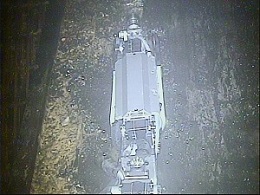
The Robot that failed due to radiation in Nuclear Reactor #2 at Fukushima Daiichi
Credit: The Tokyo Electric Power Company
Two other robots were also abandoned after one became stuck on its way to where they think the radioactive spent fuel is, and the other after failing to find the fuel. One of the robots’ cameras actually began to malfunction due to the high levels of radiation on one of the attempts.
Tokyo Electric Power Company Holdings, Incorporated, Scorpion Robot: https://www.facebook.com/OfficialTEPCOen/videos/1348040575255238/
The reality is, the Tokyo Electric Power Company (Tepco) needs smarter and tougher robots - a fact the Director of Decommissioning has admitted.
Toshiba manufactured the Scorpion Robot and are now purportedly developing the robot that is needed to probe the most damaged reactor, Reactor No. 3. The company will have to go back to the drawing board to ensure this new robot will withstand and survive the radioactive material.
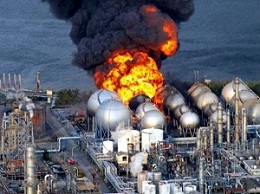
Toshiba’s engineers initially thought their Scorpion robot had the capacity to weather the radiation but realised more work to make them radiation-proof is needed. The engineers must perform a more rigorous process of ‘radiation hardening’ to ensure these next iterations do not succumb to the same pitfalls.
Despite being abandoned, the failed robots have provided engineers with some indication of where their weaknesses were - the location of the melted material. To fully ascertain why they miscarried, without having them at hand, would be difficult and will prove challenging when designing the tougher and smarter versions.
President of Decommissioning, Naohiro Masuda, said: “We should think out of the box so we can examine the bottom of the core and how melted fuel debris spreads out.” Tepco wants to have the decommissioning process completed by 2021.
The Daily Mail has released drone footage of the abandoned town. This year would mark the sixth year since the earthquake and tsunami.
Works Cited
Wehner, Mike. "Japan’s Failed Nuclear Reactor Is Still so Radioactive It Almost Killed a Robot." BGR. 14 Feb. 2017. Web. 08 Mar. 2017.
Yamaguchi, Mari. "Fukushima Cleanup Chief Urges Better Use of Probe Robot." Japan Today. Web. 08 Mar. 2017.
- Details
- Written by: Quintus Potgieter
The prosperity of many industries hinges on the sucess of engineering innovation and endeavor.
Unfortunately engineers are often only remembered once their well oiled machines, that thrust society forward, stop working. And sometimes they don’t get the recognition they deserve. The Queen Elizabeth Prize for Engineering has tried to change that disappointing fact.
First awarded in 2013, the QEPrize sets out to aard engineers for their innovation in engineering, with specific focus on innovation that has globally benefited humanity.

This year, the QEPrize was awarded to Michael Tompsett, Eric Fossum, George Smith and Nobukazu Teranishi. They received £1 million as recognition for creating the technology that allows us to take ‘selfies’ with our smartphones.
Celebrating the culmination of thirty years of work, these engineers were lauded for creating the “charged couple device (CCD), the pinned photodiode (PPD) and the complementary metal oxide semiconductor (CMOS). Basically, the technology that has improved the quality of the photos we capture with our smartphones today.
The engineers have promised to use the prize money to create a scholarship that would encourage females to follow their engineering dreams.
Despite the prize engineers will continue to go unrecognized; some will receive it, but only after very many years.
The Black Box
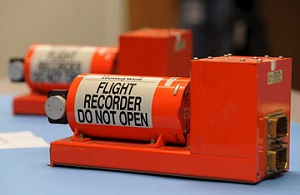
David Warren, the Australian inventor behind the flight data recorder and cockpit voice recorder (or as we like to call it, ‘the black box’) waited 50 years for his 15 minutes of fame. Warren engineered the ‘black box’ after the first commercial airline disaster in 1953. He said:
“There were no witnesses, there were no survivors, and there wasn’t any obvious reason for what had caused it. Now, you gotta find out what caused it, to stop it from happening again.”
Warren came up with the idea for the recorder after visiting a fair and observing a miniature personal voice recorder that typists would use to type up transcripts of what their bosses wanted them to. He implemented a similar system into his first prototype for the black box.
The in flight recorders crucial to airplane crash investigations we know today, are all thanks to David Warren. It was only in 2002 that he was recognized and deemed the Officer of the Order of Australia (AO) for “service to the aviation industry, particularly through the early conceptual work and prototype development of the black box flight data recorder.”
Years later, David Warren’s son, Peter, has said he believes that “scientists and people of vision”, in Australia, are not sharing their innovations with the world because of a “colonial mindset” that has made them believe that they are not able to innovate for a global market.
Hidden Figures
The President of the United States, Donald Trump, in a recent signing of an executive order, encouraging the hiring of women in STEM fields said:
“Today I’m signing two bills that promote women entering and leading the STEM fields - science, technology, engineering, and math. Currently, only one in four women who get STEM degrees is working in a STEM job - which is not fair…”
There is a battalion of women in STEM fields that have paved the way for the future women engineers, however. They are only now getting their names stamped into the history books and Hollywood movies.

The true-story-turned-movie, Hidden Figures, is a story that encourages not only females to follow their dream careers in STEM fields, but encourages black women to do it too. The film follows the black mathematicians that assisted NASA with their expertise in the Space Race.
Margot Shetterly, the author of Hidden Figures, the book the movie is based on, spoke to Al Jazeera:
“They happened to be very talented, good at their jobs, mathematicians, scientists, engineers, but they were also just normal people. I got an up-close look at the fact that science could be done by anyone.”
Shetterly’s father was a climate scientist at NASA’s Langley Memorial Aeronautical Laboratory. Based on her research, she reports that, in 1970, 1% of Americans engineers were black. It had risen to 2% by 1984.
In an excerpt from the book, Shetterly writes that at least 50 black women were involved in mathematical, scientific and engineering roles from 1943 to 1980:
“NASA’s African American employees learned to navigate their way through the space agency’s engineering culture and their successes in turn afforded their children previously unimaginable access to American society.
Of course, there is a long history of not giving female STEM professionals the recognition they deserve. The media forget to applaud the women who helped put American men on the moon.
Margaret Hamilton, a systems engineer who wrote the code that defined the Apollo 11 mission, was awarded the Presidential Medal of Freedom by Barack Obama in 2016.
She was the Director of the Software Engineering Division of the MIT Instrumentation Library. She and her team developed the on-board flight software for the Apollo space program.
In a photo she is seen standing next to the books of code she wrote.

Margaret Hamilton with her code, lead software engineer, Project Apollo
Source: Wikipedia
If history is anything to go by, the future of STEM professionals (male and female) is bright. And hoefully, at some point, they will be recognized for the work they are doing today.
Works Cited
AlJazeeraEnglish. "The Stream - NASA's 'Hidden Figures'" YouTube. YouTube, 15 Sept. 2016. Web. 28 Feb. 2017.
"Hidden Figures: The History of Nasa's Black Female Scientists." The Observer. Guardian News and Media, 07 Feb. 2017. Web. 28 Feb. 2017.
Shetterly, Margot Lee. Hidden Figures. Place of Publication Not Identified: William Collins, 2016. Print.
Tovey, Alan. "The Engineers Who Made 'selfies' Possible Share £1m Prize." The Telegraph. Telegraph Media Group, 01 Feb. 2017. Web. 28 Feb. 2017.
- Details
- Written by: Quintus Potgieter
Chances are, if you work in an office environment, you’re faced with the temperature dilemma: you are either too hot or too cold. This is exacerbated in an open plan office space; an environment where the aircon’s remote becomes a highly disputed weapon. And it’s all thanks to engineers!
According to renowned Australian author and science commentator, Dr Karl Kruszelnicki, the world sees 20% more air conditioning unit sales yearly.
He makes a very interesting assertion regarding the dispute over optimal office temperatures in modern day offices. He says that air conditioning units benefit men only.
He writes: “You know what I mean - the men are fine in shirt sleeves, but the women have to wear cardigans and scarves.”
Kruszelnicki chalks it up to the air conditioning standard that has been used for the last 50 years; Standard 55.
Standard 55 first made its appearance in 1966, when the American Society of Heating, Refrigeration and Air Conditioning Engineers decided to compile a long list of factors that would impact the ventilation and air conditioning of buildings.
One of the items on the checklist included the clothes that workers wear. “And you guessed it, the human they chose to base that on was a 40-year-old man, weighing 70 kilograms, and dressed in full 1960s business suit,” Kruszelnicki said. Interestingly even the metabolic rate of an individual was considered, a man’s metabolic rate.
It is well known that metabolic rates in men and women differ in most cases. It is this fact that results in women reacting differently to temperatures compared to men.
Kruszelnicki thinks that changing the indoor temperature from 22 to 25 degrees Celsius will level the playing field and empower both sexes.

Engineers are, however, working to completely redefine the game.
At the University of Colorado Boulder, Xiabo Yin and Ronggui Yang have developed a metamaterial that might change the entire HVAC industry. Working on a USD$3 million budget from the Department of Energy’s Advanced Research Projects Agency-Energy (ARPA-E), the pair created a “glass-polymer hybrid”, which was placed under a layer of silver.
They have published a journal in the Science journal. The report is entitled Scalable-manufactured randomized glass-polymer hybrid metamaterial for daytime radiative cooling.
The material can be spread out on a roof and deflect any solar radiation that it receives. The engineers say it can “cool objects under direct sunlight with zero energy and water consumption.”
The material is just a fraction thicker than aluminium foil, measuring 50 micrometers.
“Just 10 to 20 square meters of this material on a roof could nicely cool down a single-family house in summer,” said Gang Tan, an associate professor at the University of Wyoming’s Department of Civil and Architectural Engineering. The engineers add that it could also benefit thermoelectric power plants.
“We feel that this low-cost manufacturing process will be transformative for real-world applications of this radiative cooling technology,” said Xiaobo Yin, the co-director of the metamaterial research.
Furthermore, Yin commented that the material can be placed over solar panels. “Just by applying this material to the surface of a solar panel, we can cool the panel and recover an additional one to two percent of solar efficiency. That makes a big difference at scale.”
Heavy energy consumption
The metamaterial might be able to reduce more energy consumption than Australia’s proposed solar powered air conditioning units. The Department of Environment and Energy tested solar-powered air conditioning systems last year.
The Department tested different units in two categories: ‘solar thermal’ and ‘solar photovoltaic air conditioners’.

Example of a solar thermal cooling air conditioner
Source: http://homeservicenowvisalia.com/
The hope was that the solar thermal units could become the new kid on the block and would drive down electricity bills for buildings all over Australia. However, in a report, the Department of Environment and Energy called the units a “marketing gimmick that offers no improvement in the performance or amenity of the air conditioner.”
The photovoltaic alternative proved to be inefficient too; the air conditioner only worked at 75% of its capacity.
As a result, the units in question were removed from the market. Experts are instructing consumers to buy efficient, energy saving air conditioners before putting money down on inefficient solar competitors. The technologies will inevitably improve with and costs reduce in time.
Works Cited
"Chill Out! Newly Engineered Material Can Cool Roofs with Zero Energy Consumption." Mechanical Engineering | University of Colorado Boulder. Web. 01 Mar. 2017.
"Freezing in the Office? It's Because Air Conditioning Standards Are Sexist." Radio National. 27 Feb. 2017. Web. 01 Mar. 2017.
- Details
- Written by: Quintus Potgieter
Strides are continually being made in road safety engineering. Making roads safer and more efficient is the work of civil engineers across the globe. The safest option would be automating all cars around the world. Ford, Google, Mercedes-Benz, Tesla and Uber are looking at their implementation in the United States by 2021, but that is still some time away and there are still a few kinks that need to be addressed.

Consequently, engineers are in charge of producing novel approaches to road safety up until human error can be taken out of the equation.
America’s Guardrails
In a report by the U.S. Department of Transportation's Federal Highway Administration, transportation engineers have taken a second look at what affects the crashworthiness of a guardrail.
“Because these crashworthiness tests are conducted with vehicles traveling at a speed of 100 kilometers per hour (62 miles per hour), if a vehicle hits a guardrail at a higher speed, the guardrail may not operate optimally.”
The Colorado Department of Transportation recently inspected their guardrails state wide. They found that 144 sections of guardrail would not be able to absorb the energy of a crash, which in turns put their drivers in danger.
The Federal Highway Administration was defrauded in 2005 by an engineering company known as Trinity Industries. Trinity changed the design of their guardrails without alerting the Administration. The guardrails were found to be unsafe, failing to prevent eight or more deadly accidents.
The following situation reveals the complexity involved. Recently the Department of Transport’s Spokesperson Mark Nagi was required to respond to questions about a crash on a road that had neither guardrails nor barriers.
The crash occurred in Cumberland County in Maine in November 2016. A truck barrelled from the eastbound roadway into the westbound roadway and smashed into a car hauler and another passenger vehicle. The three drivers involved in the accident died.
“We simply cannot design or construct a guardrail that is completely safe in every situation. There is always a hazard associated with a vehicle hitting a guardrail,” Nagi said.
According to InterestingEngineering.com, 1.25 million die as a result of a road traffic crash. These crashes sometimes involve motorists losing control and hitting guardrails.
This issue aside, engineers are trying to figure out how to implement a ‘one size fits all’ approach to guardrails. They know that the speed at which a vehicle approaches a guardrail and the size of the vehicle, could produce several different results.
The question is: Can guardrails be designed to prevent horrible accidents and death?
The new designs
Korean engineers from a company named ETI Ltd. believe they have re-invented the guardrail. They believe that their design will ensure a safer guardrail collision.
The barriers have aptly been named ‘roller rails’. High-speed impacts, as shown on the video, redirect the car back into the lane the car initially came from through rotational energy. This is compared to the alternative, which would be hitting a guardrail straight on and seeing a sizable amount of damage as a result.

The video has been shared around the internet and subsequently gone viral. However, the designs are not entirely new. An Australian company named KSI Global had virtually identical guardrail designs years ago; shown in a video that dates back to 2014.
“Safety roller will minimize the damage of people and vehicles by absorbing collision shock,” says KSI Global. The company also says installation and maintenance costs will be significantly lower compared to traditional guardrail installations.
The rolling barrier system is yet to be adopted by the majority of countries; however a trial is being run in Malaysia.
The one concern with this system that has experts worried is that cars will be deflected back into other cars.
Works Cited
Sorokanich, Bob. "This Roller Guardrail Seems Brilliant, Except For One Major Problem." Road & Track. 10 Feb. 2017. Web. 21 Feb. 2017.
Tegna. "10Investigates: Guardrail Guidelines." WBIR. Web. 21 Feb. 2017.
"This New Korean Rolling Barrier System Could Save Millions of Lives." Interesting Engineering. 20 Nov. 2016. Web. 21 Feb. 2017.
- Details
- Written by: Quintus Potgieter
Engineers and scientists have a profound impact on society. The businesses that utilize STEM careers are the tools that build the gross domestic product of a country. Their inventions and innovations change the way the world does things all the time.
However, in the modern day blur of news from media outlets, we seldom hear of the engineers who are tirelessly innovating and working to keep things running. Mostly the focus is on the individuals who preside over engineers, the Elon Musks, the Steve Jobs and the Richard Bransons of the world.
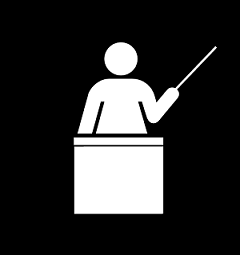
Engaging the public
The Associate Dean for Iowa State University’s College of Engineering, Sriram Sundararajan wants this to change. He believes scientists and engineers need to make a concerted effort to communicate with the public
He says that it is not enough for engineers to merely publish technical journals, they need to think about ways to engage the public.
“Being able to communicate effectively to multiple audiences is an important skill for scientists and engineers. And so we want to help faculty and graduate students develop a broader impacts portfolio,” he says.
Iowa State University has created an initiative incorporated into a graduate course that will help STEM graduates communicate their projects to the public. The initiative is named ‘Strengthening the Professoriate Initiative’.
Resources will be made available to faculty members, postdoctoral research associates and advanced graduate students to encourage them to expand on their expertise. The aim is to assist them generate further research and development and to engage the public in their grant proposals and research projects.
The graduate course will focus on how technical work can be applied to benefit society. It will clarify how their engineering designs impact the society they live in.
“You need to encourage individual faculty and graduate students to develop broader impacts and public engagement. You need to develop a structure to provide them with the tools they need to be successful,” said Sriram Sundararajan
Why engineers should speak out
Professor Dereck Sparks, an Emeritus Associate Professor of Foundations and Soil Mechanics at the University of Cape Town says that civil engineers should speak out against political interference in engineering. He writes:
“As civil engineers we cannot run away from politics. When we see faults, we should supply alternative ideas, because inaction is not an excuse. Politicians and persons who do not have a proper professional training in civil engineering should not be making decisions relating to the nature and location of major civil engineering works.”
He initially wrote his journal entry in response to the misappropriation surrounding the upgrading and building of stadiums for the 2010 Fifa World Cup. However, what he asserts remains true today.

When accidents happen in engineering industries, it is revealed that ill-maintenance is to blame. Recent evidence shows that the government of Oroville, California were warned, twelve years ago, about the recent erosion of the spillways at the Oroville dam. The erosion has caused the evacuation of more than 100,000 people due to concerns of flooding.
Perhaps if these engineers had been more vocal, they could have helped prevent the disaster. Engineers should be speaking up and engaging the public on matters that directly affect them.
Engineers and politics
A more positive example of how politics has directly led to a shift in the engineering community is the politicization of global warming. The politicization of globally rising temperatures has led to a huge boom in renewable energy technology manufacturing.
Although there are alternative views on this: the President of the United States, Donald Trump, wrote on Twitter in 2012: “The concept of global warming was created by and for the Chinese in order to make U.S. manufacturing non-competitive.”
Needless to say, some scientists and engineers are concerned about their futures in industries that profit from global warming research and development.

A nonprofit organization named 314 Action (314 being a reference to the number for pi) wants to train individuals in STEM (Science, Technology, Engineering, Mathematics) jobs in hopes that they could become eligible to run for office in the United States.
The group believes that climate change, next to terrorism, is one of the “greatest challenges facing this generation.”
“The goal is not to politicize science, but to get [STEM graduates] involved in politics. When the man who is to lead this country claims climate change is a hoax, we need people willing to stand up for the facts,” said founder of the group, Shaughnessy Naughton.
The Dean of Engineering of the Engineering Institute of Technology, Steve Mackay, has also suggested that engineers get involved in politics:
“You have to get involved because you, as engineering professionals, have something more than most of those in parliament; you have an objective. Parliaments are riddled with lawyers, accountants and people that perhaps don’t have the necessary technical knowledge to make considered technical decisions. You have the potential to make a major contribution.”
Works Cited
IowaStateUNews. "Iowa State Engineer Addresses Need for Scientists, Engineers to Engage the Public." EurekAlert! Web. 22 Feb. 2017.
"Sign Our Letter to President Trump." 314 Action. Web. 23 Feb. 2017.
Sparks, Dereck. "Civil Engineers Should Speak out." Dereck Sparks. South African Institution Of Civil Engineering (SAICE), 01 Sept. 1976. Web. 22 Feb. 2017.
- Details
- Written by: Quintus Potgieter
Sin City just became ‘holier than thou’. The gambling capital of the world, Las Vegas, is now completely powered by renewable energy. Or is it? It seems that Las Vegas’ plans to move toward 100% renewable energy has produced some misinformation.
Popular Mechanics, a well known engineering news magazine, posted a fake story about Vegas back in December 2016. The story professed that Las Vegas was “the largest city in the country to run entirely on renewable energy.”
The city does indeed have a large-scale solar facility, but only the city’s government buildings are being powered by the sun. The facility in question is the Boulder Solar 1, a facility that opened its doors in December 2016. And it is impressive; it will reportedly save the city of Las Vegas USD $5 million.

NV Energy, the company in charge of Vegas’ large-scale renewable projects just brought Boulder Solar II online as well. It will produce 550 MW of solar energy for Las Vegas. These two projects are not alone, they joins 43 other renewable energy projects that are currently operating in Nevada.
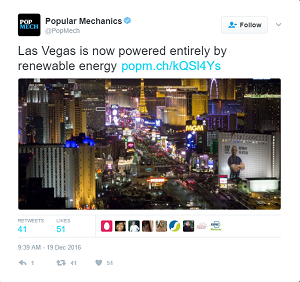
Title: Popular Mechanics publishes Fake News
Credit: Popular Mechanics Twitter
A common misconception is also at play. The vibrant-looking hotels and casinos, pictured in a host of movies, are not in the city of Las Vegas; they are in two unincorporated towns named Paradise and Winchester, Nevada. They are governed by Clark County.
In other words, none of these hotels or casinos are being powered by renewable energy; they remain dependent on fossil fuels to a large degree. Popular Mechanics, and other news channels that ran the story, had to re-word their articles.
Not even close
Writing for Forbes, Robert Rapier, a chemical engineer wrote:
“With natural gas generating four times the electricity of renewables for the state, it isn’t mathematically possible for Las Vegas to be running entirely on renewables. Per EIA data Las Vegas runs primarily on natural gas. This is a major accomplishment for the Las Vegas city government, but it is important to note that its energy consumption is a tiny fraction of the overall city.”
However, perhaps the hopeful, inaccurate headlines present an interesting topic of conversation for the future. With casinos running 24/7 in ‘Vegas’, perhaps it is time to actively pursue renewables for the commercial sector - especially for those cities that ‘never sleep’.
Setting examples
Engineering companies and the commercial industry are continually being encouraged to make use of renewable energy technologies in their manufacturing and industrial operations.
The U.S. Energy Information Administration (EIA) published a report in 2012 named: Commercial Building Energy Consumption Survey. In their summary, they concluded that the energy used in commercial buildings was produced by: electricity (61%), natural gas (32%), district heat (5%) and fuel oil (2%).

However, companies have begun to take matters into their own hands. Electronics engineering company, Apple, have joined an initiative named RE100. The initiative encourages companies to move all of their operations toward renewable energy. Be it the powering of their stores, or the manufacturing of their items.
Apple, by 2015, had been operating 93% of their global operations with renewable energy. Lisa Jackson, Apple’s vice president for Environment, Policy and Social Initiatives, said:
“Apple is committed to running on 100 percent renewable energy, and we’re happy to stand beside other companies that are working toward the same effort. We’re excited to share the industry-leading work we’ve been doing to drive renewable energy into the manufacturing supply chain, and look forward to partnering with RE100 to advocate for clean-energy policies around the world.”
Other companies which have joined the initiative include: IKEA, Adobe, Autodesk, BMW Group, Coca-Cola Enterprises, Facebook, General Motors, Google, and more.
Adding global pressure
Greenpeace South Africa have also realized how useful renewable power could be in a country where the power utilities are sometimes overwhelmed.
They recently released a report named: Shopping Clean: Retailers and Renewable Energy. The group wrote:
“If Woolworths, for example, were to be 100% renewable energy powered, this would liberate enough electricity for 55,000 households in South Africa. Pick n’ Pay’s electricity consumption is enough to power 65,000 households while Massmart and Spar could power 53,000 and 5,400 households respectively.”
Whilst the hope is that companies will migrate their operations over to renewable energy, as the confusion around Las Vegas shows, it is not as easy as just writing it into existence. Engineers need to be consulted and plans put together to ensure that efficient technologies are available for malls, hotels and casinos, the business sector at large, and manufacturing industries.
Perhaps one day you’ll be pulling the lever on a slot machine powered by a wind turbine. A fact that may be a consolation for the money you may be losing!
Works Cited
"Apple Joins RE100, Announces Supplier Clean Energy Pledges." Apple Newsroom. Web. 20 Feb. 2017.
Rapier, Robert. "Sorry, Las Vegas Isn't Close To Running Entirely On Renewable Energy." Forbes. Forbes Magazine, 29 Dec. 2016. Web. 20 Feb. 2017.
Account, Popular MechanicsVerified. "Popular Mechanics (@PopMech)." Twitter. Twitter, 20 Feb. 2017. Web. 20 Feb. 2017.
- Details
- Written by: Quintus Potgieter
In 2016, the United Nations declared that the internet was to be considered a human right, like running water.
The U.N. has enduringly struggled to enforce international law so for this issue the ruling was met with some criticism. Widespread access to the internet is further complicated in certain countries, such as North Korea and China, who regulate their telecommunications.
The Internet of Things - and the oncoming fourth industrial revolution - will be exposing the internet to an even wider audience. Thanks, in most part, to the engineers who are continually innovating in the telecommunications sector.
This technological expansion will have a profound effect on industry and society as a whole, but presents a unique opportunity for education. Especially, education in third world countries.
Internet infrastructure
Internet infrastructure in Africa has largely leapfrogged the continent over the old technologies and embraced new broadband technologies.
As 4G networks like LTE-Advanced (LTE-A) and LTE-Advanced Pro (LTE-A Pro) make their way into Africa, the 5th generation networks are in the beginning stages of being tested in the United States and Europe.
Deloitte Global’s research report revealed that, at the end of 2016, “over half of all models of 4G [smart] phones were LTE-A capable”. Technologies that can facilitate digital learning are being engineered to work more efficiently yearly. However, they need to be engineered with the third world in mind.
ADSL (Asymmetric digital subscriber line) broadband technology, especially in South Africa, is slowly being phased out due to the rampant criminality surrounding the technologies. The internet is transmitted through copper telephone lines and this copper is regularly stolen and sold on black markets.

Fibre optic cables / Pixabay.com
It is estimated that cable theft has cost South Africa $321 million. One of the main internet utilities in South Africa, Telkom, forked out $12.8 million in 2016 alone to repair cable theft damage and to appoint security companies to prevent it from happening.
As a result, engineers are trying to move from ADSL to more secure, wireless networks; LTE and fibre. They have replaced the dated technology with technologies that can be accessed wirelessly by the end user. Then there are wired fibre technologies. Thankfully for the telecommunications companies, fibre is not a valuable commodity to criminals looking to make a quick buck.
Infrastructure = education
Europe’s leading HR and learning analyst, Fosway Group, conducted a survey targeting 1,000 learning and development professionals.
The results indicate that there is a general belief that digital learning improves learning availability, speed of learning and learner engagement. The CEO of Fosway Group, David Wilson commented:
“It’s important to uncover the realities of digital learning to get to the heart of what’s really working - and not working - for organizations in practice as well as their experiences with digital learning suppliers. It’s about more than just the tools and technologies.”
Their report also revealed that education platforms which host video learning and mobile learning are seeing an increased demand from consumers, compared to traditional on-campus alternatives.
The one determining factor delaying high quality, widely accessible internet, is access.

Once internet infrastructure is established, with affordable data rates, basic and higher education distance learning platforms will undeniably be set up.
The final hurdle, for impoverished communities, is gaining access to physical hardware that will be able to make the most of the established internet infrastructure.
A novel approach being tested around the world is making online curricula available to less privileged communities and rural areas. This content is being compiled by some of the best higher education institutions.
Telecommunication engineers are facilitating this revolution in education. Educators, however, need to actively investigate how they can best exploit it to benefit their students.
Works Cited
"TMT Predictions 2017: Overview | Technology, Media, and Telecommunications." Deloitte Luxembourg. 20 Jan. 2017. Web. 06 Feb. 2017.
L&D. "The Key Drivers for Digital Learning." L&D. Web. 06 Feb. 2017.
Potgieter, Quintus. "Cable theft leads to LTE and fiber push for South Africa" Home - Engineering Career. Web. 06 Feb. 2017.
- Details
- Written by: Quintus Potgieter
When natural disaster strikes, infrastructure suffers: buildings, roads, power supplies, water, lighting.... In the aftermath, the helping hand of others is sometimes the only thing that can soften the blow. But in some cases, in the long term, it can do more harm than good.

Foreign aid has often been likened to ‘giving a fish to a person who is hungry’. Philanthropy, on the other hand, is more about ‘teaching someone how to catch a fish so that he can fish in the future too’. The lines do, however, get blurred.
For instance, in the name of philanthropy, many engineering technologies are doled out to impoverished nations. Like the analogy of providing just the fish to the hungry, the gesture may appear commendable, but it is worthless if a nation is unable to apply the technologies meaningfully.
It can even be counterproductive: foreign aid can create a dangerous dependency, destroying local entrepreneurial endeavour and collapsing markets. The practice has faced criticism, most notably in a documentary named Poverty Inc.
The solar streetlight business
In the Poverty Inc. documentary, a specific example of foreign aid is seen to directly disrupt a renewable energy company in Haiti, after the earthquake of 2010.
Credit: Inter Press Service News Agency (http://www.ipsnews.net/)
3.1 Haiti's solar entrepreneurs from POVERTY, INC. | The Movie on Vimeo.
Enersa, a company that trained lighting technicians to engineer solar panels for streetlights in Haiti, was impacted negatively by foreign aid. Enersa is completely owned and operated by Haitians. One of the co-founders of the company Jean-Ronel Noel, learned how to manufacture solar panels on the internet. He used MIT’s free online course materials to learn how.
“I was able to use the OpenCourseWare to learn the principles of integrated circuits. I found out that I could use an existing integrated circuit to make things more efficient, and I wanted an explanation about how it worked. I was able to learn this through the MIT OpenCourseWare,” he said, in an interview with OpenCourseWare.
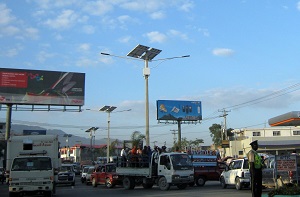
After the earthquake, NGOs donated solar technologies to the earthquake-effected country and Enersa’s sales fell; the company went from selling 50 solar panels a month to selling only 5.
The Clinton Foundation, founded by Bill and Hillary Clinton, had allegedly invested in green energy in Haiti to boost its recovery. The foundation, with the help of NRG Energy and the Solar Electric Light Fund (SELF) donated the solar streetlights to Haitian communities. On their website, they said:
“The solar streetlights that the Clinton Foundation provided are particularly important for these communities…”
African experts perceive foreign aid to be a problematic force that precludes African artisans, technicians and engineers from gaining the benefits of entrepreneurial profit due to the barrage of free technology dumped on them.
Steve Mackay, the Dean of Engineering at the Engineering Institute of Technology, believes that the foreign investment of technologies into poorer nations needs to be approached cautiously and thoughtfully. In his video named The Barefoot Engineer, Mackay said:
“One of the critical things when you do get involved with projects in the developing world is to avoid highly sophisticated infrastructure or advanced manufacturing. The trick is to go for barefoot engineering. This involves the use of practical, robust technology appropriate to the needs of the community you’re in.”
Alongside this more circumspect approach to donating technology, is training and education not essential too? With this expertise there would be growing numbers of those with the skill and the means to ‘fish’ for themselves. Coordinating and delivering education may be considered too challenging logistically, but then with the new online teaching technologies abounding many opportunities are emerging.
Engineering prosperity in poorer nations
The University of Oxford have announced their very first MOOC (Massive Online Open Course) named ‘From Poverty to Prosperity: Understanding Economic Development in 2017.’ These kinds of freely available courses are seeing large numbers of African enrollments.
They believe that to secure Africa’s prosperity, education is the key.

The Peace Corps, a volunteer program run by the United States government, deploys engineers out into the field. Its aim is to work with people in impoverished nations with the aim of finding workable solutions to problems. A returning chemical engineering volunteer took to social media site, Reddit, to deliver his opinion on what he had experienced:
“No amount of money will solve problems. People who set good examples and enable other people to solve their own problems...solve problems. Foreign development is a game and it takes many moves to have an impact. Those that are there for the short game fail. “
Works Cited
"MIT OpenCourseWare." MIT OpenCourseWare.. Web. 15 Feb. 2017.
"Recent BSEE Graduate Looking to Volunteer and Help Others Abroad (EWB, Peace Corps, Etc.) • /r/engineering." Reddit. Web. 14 Feb. 2017.
Scarlet Cronin / Gregory Milne October 13, 2016, Clinton Foundation July 5, 2016, and Donna E. Shalala July 29, 2015. "Powering Haiti with Clean Energy." Clinton Foundation. Web. 14 Feb. 2017.
- Details
- Written by: Quintus Potgieter
Automated systems are changing our world daily. New technologies make their way into workplaces annually, changing the way a company operates and changing the face of its workforce. Sometimes, automated software crunches the numbers. But, increasingly, in engineering applications, the changing face is a robot.
Robots are the 24/7 worker. No lunch breaks. No toilet breaks. No sick leave. They do, however, need a unifier, to enable them to work together. They need a network.
Robots networks are required to facilitate their functions; a network architecture that is fast enough and robust enough to deal with the many automated systems connected to it – all working simultaneously.
A 4th generation cellular network will make way for a 5th generation with higher speed bandwidth and newly designed industrial applications. New protocols will be invented so that systems can talk to each other and work in unison. It’s all about the Industrial Internet of Things (IoT) and what it is doing for the automation of processes in business.
The industries most prone to IoT revamping in the short-term are industrial environments and agricultural industries. As new technologies make their way into the industry, regulations and legislation need to be put into place.

Credit: Sensor-Technik Wiedeman GmbH
Sensor-Technik, a German engineering company, specializes in connecting mobile machines to IoT-like networks. They say that “monitoring surroundings” and “situation awareness” will be very important in the coming years, as automated machines continue to be manufactured.
How these networks - that facilitate the aforementioned ideals - will integrate with robotics, is something that robotics manufacturer KUKA is closely monitoring.
Interconnected and automated construction and mining machinery is increasingly being employed in industry. There is no surprise, therefore, that safety at these sites is improving; there are fewer personnel to harm and the opportunity for human error is reduced too.
Rio Tinto’s autonomous mines

Credit: BBC/Click
Rio Tinto, a mining company with mines in Australia and around the world, has two iron ore mines in Western Australia that use some of the latest in automation technologies. Robot drillers, driverless iron ore transporting trains and automated rock breakers are all being employed. The company claims that their 73 automated haul trucks are 15% cheaper to run than manned vehicles, and inevitably more efficient.
The mine is able to function twenty-four hours a day, seven days a week. They are reliant, however, on their control centers, where humans are required.
John McGagh, head of innovation at Rio Tinto told BBC’s Click, commented that 5% of the world’s energy goes into the crushing and grinding of rocks. He went on to explain why their automated systems are invaluable; the efficiency of these systems results in energy cost savings.
There remain, however, many industrial applications where personnel and automated robots work alongside each other. This is indeed gratifying, but can present uniquely dangerous safety situations.
The legislation
The European Union have tried to keep ahead when it comes to robot and human coexistence. EU-members have called for the Legal Affairs Committee to secure industry-wide and EU-wide safety standards for robotics.
The monitoring of how robotics interposes into daily human life is the focus of the new legislation. EU members believe that “guaranteeing a standard level of safety and security” is vital, particularly with the speed at which the robotics industry is evolving.
Rapporteur, Mady Delvaux said:
“A growing number of areas of our daily lives are increasingly affected by robotics. In order to address this reality and to ensure that robots are and will remain in the service of humans, we urgently need to create a robust European legal framework.”
Safety standards for collaborative industrial robots already exist thanks to the EU. The standard is named ISO 10218, which covers: Safety of Industrial Robots, Part 1 and Robot systems and integration, Part 2. In the coming months and years, robotics standards will burgeon and become embedded into law to prevent accidents, but also to ensure that the right steps are taken should they occur.
The EU Committee believes that the ethical standards and liability of accidents involving automated vehicles (including self-driving cars) must be developed directly. The reality is that mobile robots will integrate into everyday human life imminently.
Works Cited
Krüger, Jens. "Sensors – Situation – Safety." MobilTron 2017. Web. 01 Feb. 2017.
"Robots: Legal Affairs Committee Calls for EU-wide Rules." News | European Parliament. Web. 01 Feb. 2017.
Tees44. "RioTinto Automation- BBC Click." YouTube. YouTube, 16 Nov. 2014. Web. 01 Feb. 2017.
- Details
- Written by: Quintus Potgieter
Graphene, a carbon compound discovered in 2004, is now known as one the strongest materials in the world. At only one atom think it is also one of the most lightweight.
Impressively, it has further benefits; it conducts electricity and is water-repellent too.
These qualities make it very attractive for product design, but engineers have had trouble converting it from 2D to 3D applications.
The US Army is so impressed with this microscopic sheet of carbon that they have funded MIT research into graphene microchips – they are hoping to vastly expedite their capacity to process information.
The researchers showed what a flow of an electric current would do to one sheet of graphene. They concluded that a flow of electric current can “exceed the speed of slowed-down light” on the sheet and achieve something comparable to a sonic boom - just with light. They’re calling it: the optic boom.
Marin Soljačić, a professor of physics at MIT, explained: "This conversion is made possible because the electronic speed can approach the light speed in graphene, breaking the ‘light barrier’”. Just as breaking the sound barrier generates a shock wave sound, he says.
In the case of graphene, this leads to the emission of a shock wave of light, in two dimensions. If this research goes any further we may see some movement in a light generation technology to compete with LED technology.
The heat transfer and electric conductibility of graphene has shown that graphene could be utilized to transfer heat from a light-emitting diode (LED), which in turn, would increase its efficiency.
Normal carbon fibre will allow light to pass through it, showing its weak spots, whereas graphene appears utterly void of light. The researchers say their breakthroughs could have significant benefits for electronics technologies. The following photograph is from the Global Cycling Network (GCN), which recently completed a report on graphene.

Wait! Why would cyclists care about graphene?
Cyclists - and some engineers - are very particular about their bikes. Patents for products utilizing graphene are starting to pop up all over the world. The promise of a sturdy, waterproof and lightweight frame is exactly the kind of thing cyclists are into.
A company named Dassi, engineered the world’s first graphene bike frame. The graphene is harvested in the labs of a company named Perpetuus. They are carbon technology specialists, who, according to the GCN, produce the most graphene in the world. They produce 400 tonnes per year.
Based on the GCN report, the engineers at Dassi are hoping to build a graphene bike frame that weighs only 350 grams, and is the more durable than carbon fibre frames. The frames they currently produce are not completely graphene-based.

Dassi’s Graphene Bike Frame
Credit: Dassi.com
Graphene could also produce the next generation of clean fuel cells for the future powering of automobiles. Graphene purportedly allows protons to pass through it, which allow hydrogen to become isolated. (This is something scientists had been trying to achieve prior to the discovery of graphene.) The result would be clean fuel cells being burned for clean electricity.
Graphene’s chemical makeup, in its two dimensional form, makes it one of the strongest elements in the world today. But, transferring graphene into a three-dimensional material has been the recent focus of engineers. If graphene can successfully be implemented into three-dimensional objects, it could have far-reaching benefits for engineering industries. Researching engineers at MIT have investigated:
Works Cited
David L. Chandler | MIT News Office. "Researchers Discover New Way to Turn Electricity into Light, Using Graphene." MIT News. 13 June 2016. Web. 24 Jan. 2017.
"One of the Strongest Lightweight Materials Known." YouTube. 06 Jan. 2017. Web. 24 Jan. 2017.
Globalcyclingnetwork. "The Next Carbon Fibre? Why Graphene Could Be The Future Of Bikes." YouTube. YouTube, 22 Jan. 2017. Web. 24 Jan. 2017.
